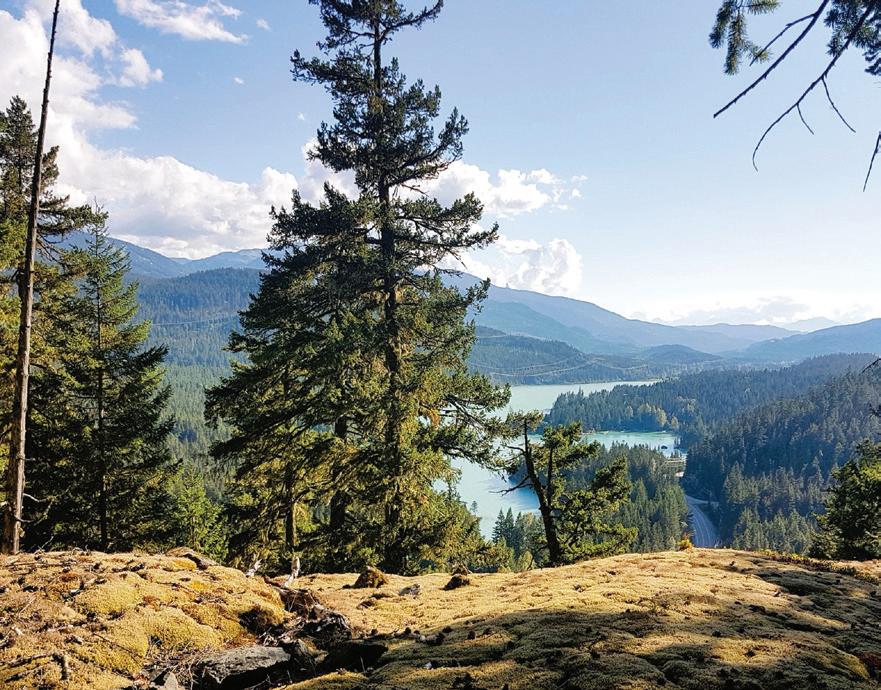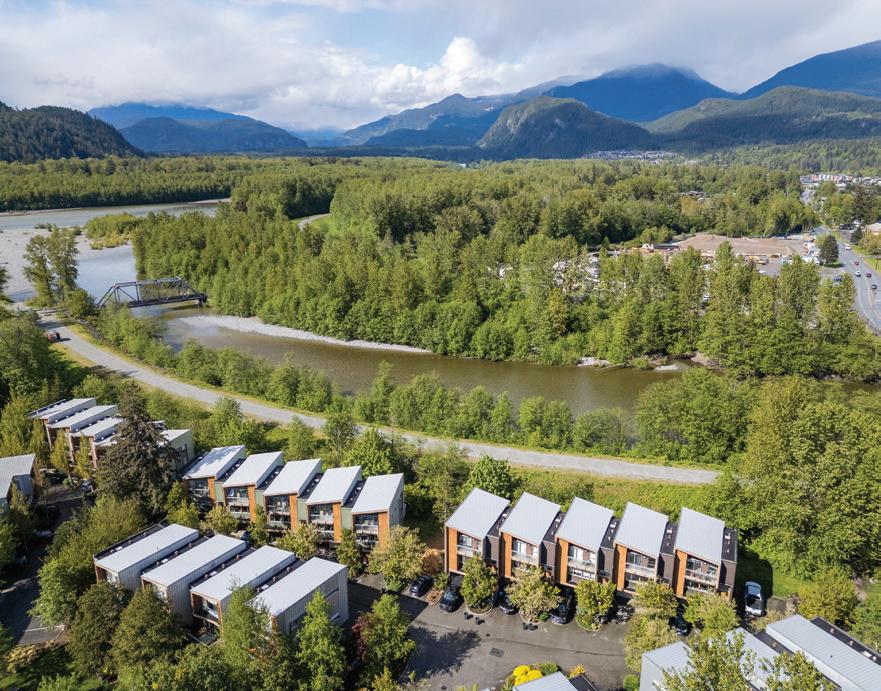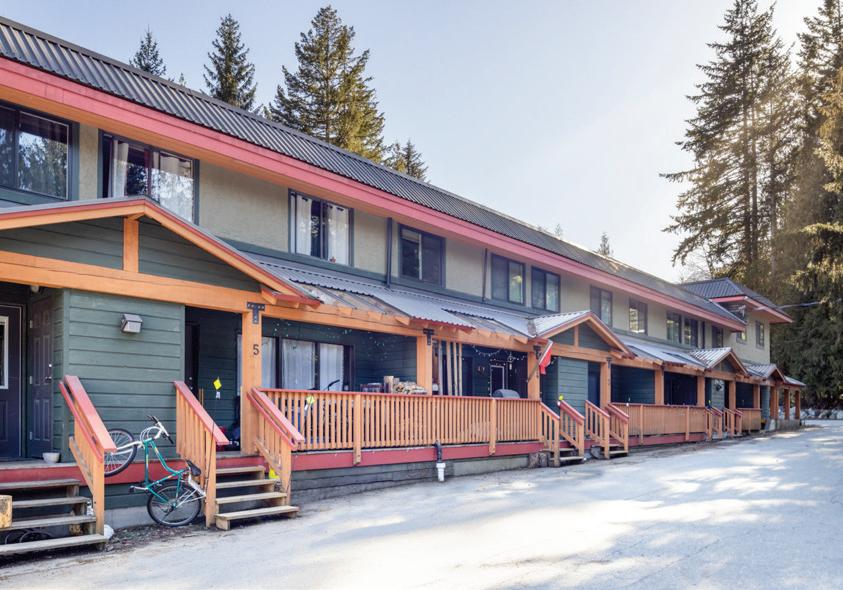


































































































As GoFundMe disaster fundraising surges in Canada, early evidence suggests the wealthy benefit most. - By Stefan Labbé
Fines for illegal short-term rentals in Whistler will soon jump 200 per cent, from $1,000 to $3,000 per day.
Huge crowds travelled from far and wide to attend the Lil’wat Nation’s Open Rodeo on May 20.
15
It’s official: Whistler’s Jen Ford will represent the BC NDP in the Sea to Sky in this October’s provincial election.
16
Taking a tour of Durfeld Constructors’ SoLo House, the energy-efficient home of the future.
Whistler’s Francois Hebert won the 2023 ILCA Laser Masters Sailboat Championship last year—the first Canadian to do so in two decades.
A new exhibit at the Squamish Lil’wat Cultural Centre showcases the Nations’ communal approach to stewardship.
COVER Imagine if money actually did grow on trees? Wouldn’t someone eventually end up wanting all of the trees, too? What if we all had a liferaft? Would someone eventually end up wanting all of them, too? Or would we hook them all up River-of-Golden-Dreams-meets-Kevin-Costner’s-Waterworld style!? - By Jon Parris // @jon.parris.art















Publisher SARAH STROTHER - sstrother@piquenewsmagazine.com
Editor BRADEN DUPUIS - bdupuis@piquenewsmagazine.com
Sales Manager SUSAN HUTCHINSON - shutchinson@piquenewsmagazine.com
Production Manager AMIR SHAHRESTANI - ashahrestani@piquenewsmagazine.com
Art Director JON PARRIS - jparris@piquenewsmagazine.com
Advertising Representatives
TESSA SWEENEY - tsweeney@wplpmedia.com
GEORGIA BUTLER - gbutler@wplpmedia.com
Digital/Sales Coordinator KATIE DOUGLAS - kbechtel@wplpmedia.com
Production - production@piquenewsmagazine.com
Arts Editor ALYSSA NOEL - arts@piquenewsmagazine.com
Reporters
SCOTT TIBBALLS - stibballs@piquenewsmagazine.com
RÓISÍN CULLEN - rcullen@wplpmedia.com
DAVID SONG - sports@piquenewsmagazine.com
ALYSSA NOEL - arts@piquenewsmagazine.com
LIZ MCDONALD - emcdonald@piquenewsmagazine.com
Classifieds and Reception - mail@piquenewsmagazine.com
Office and Accounts Manager HEIDI RODE - hrode@wplpmedia.com
Contributors G.D. MAXWELL, GLENDA BARTOSH, LESLIE ANTHONY, ANDREW MITCHELL, ALISON TAYLOR, VINCE SHULEY
Founding Publishers KATHY & BOB BARNETT
08 OPENING REMARKS A cyberattack on the B.C. government is only the latest in a long line of serious infractions—and the trend isn’t slowing, writes editor Braden Dupuis.
10 LETTERS TO THE EDITOR This week’s letter writers share gratitude after a tragedy in the backcountry, and weigh in on Whistler Housing Authority rental rates.
13 PIQUE’N YER INTEREST Catch Pique’s new reporter Liz McDonald covering all things Whistler, or dangling from a highline on weekends.
50 MAXED OUT Not usually given to nostalgia, Max finds himself wistful for long summers of aimless travel—and campfires of all sizes.
31 THE OUTSIDER Diving back into the history of the Whistler Mountain Bike Park, and the widereaching influence of Gravity Logic.
36 FORK IN THE ROAD Canadian Environment Week is on the horizon June 2 to 8, writes Glenda Bartosh—and who even knows it’s happening?
42 MUSEUM MUSINGS In Whistler’s early days, the resort’s Spring Carnival aimed to keep people coming to the ski area well into May, after many had stashed their ski gear away for the summer.




response and wish to file a formal complaint, visit the web site at mediacouncil. ca or call toll-free 1-844-877-1163 for additional information. This organization replaces the BC Press council (and any mention of it).
ISSN #1206-2022
Subscriptions: $76.70/yr. within Canada, $136.60/yr. courier within Canada. $605.80/ yr. courier to USA. GST included. GST Reg. #R139517908. Canadian Publications Mail Product Sales Agreement #40016549.














EARLIER THIS MONTH, we learned the B.C. government was the victim of a “sophisticated” cybersecurity attack, which it later blamed on a foreign state or statesponsored actor.
According to the government, said actors made three separate attempts to breach government systems, allegedly at the direction of a foreign state.


 BY BRADEN DUPUIS
BY BRADEN DUPUIS

Public Safety Minister and Solicitor General Mike Farnworth told media on May 10 there was no evidence sensitive information, such as health data, was compromised in the attack.
Where have we heard that before?
As is the case in most cybersecurity incidents, that may be true—but absence of evidence is not evidence of absence.
In this case, the head of B.C.’s public service, Shannon Salter, told reporters the investigation into the attacks covers 40 terabytes of data—so finding said evidence may equate to finding a digital needle in a vast, opaque haystack. Doesn’t mean it isn’t there.
Not to mention the main reason the government suspects a foreign state is behind the attack is the sophisticated methods used, Farnworth said.
“Being able to do what [technical experts] were seeing, and covering up their tracks, is the hallmarks of a state actor or a statesponsored actor,” he said.
Key words, covering their tracks. Given the “sophistication” and the sheer amount of data under scrutiny, odds are, sensitive information was compromised.
Govern yourselves accordingly—that’s just the world we live in.
With the amount of data about ourselves and our personal lives we willingly give up
to participate in modern society, keeping it secure and uncompromised is a monumental task, if not wholly impossible.
The Resort Municipality of Whistler (RMOW) learned that first-hand in 2021, when it was hit hard by a ransomware attack, and forced to take critical systems offline and rebuild them from scratch.
Local officials, too, used the “no evidence” line—but smart money is on sensitive info being compromised there, too, given the extensive access hackers had to all of Whistler’s systems.
Still no definitive word on how much the entire debacle cost the municipality, both in terms of lost productivity and actual costs to rebuild the infrastructure—the RMOW was not able to provide details before Pique’s weekly deadline—but according to cybersecurity firm Cobalt, the average cost of recovering from a ransomware attack in 2023 was US$1.82 million.
evolving, fuelled by new technology and new fraudulent tactics?
According to Cobalt, worldwide costs of cybercrime are estimated to hit $10.5 trillion by 2025, while a staggering 72.7 per cent of all organizations in the entire world reportedly fell prey to a ransomware attack in 2023, according to Statista.
Ransomware was identified as the No. 1 concern among security professionals at organizations surveyed, and nearly half of all companies now have a policy to pay ransoms associated with cyber threats (up 13 per cent from 2022).
However, only eight per cent of businesses that pay ransom to hackers get all of their data back in return, according to security firm Sophos.
According to Security Magazine, there are more than 2,200 cyberattacks every day, which equates to about one every 39 seconds.
And thanks to new technology, the
but personal financial attacks are small potatoes compared to the implications of state-sponsored foreign influence.
As political columnist Rob Shaw pointed out in a May 13 column, Canada is already mired in a controversial foreign-interference inquiry, and the BC NDP owes British Columbians far more transparency than it’s giving them in an election year.
“The BC NDP is not to blame for the cyberattacks occurring. But they will be to blame soon if they keep letting the risk-averse lawyers, security analysts and bureaucrats call the shots by throttling the flow of public information,” Shaw wrote.
“We elect politicians to lead. They take the best advice of the experts, weigh the risks and make decisions in the public’s best interests. In this case, the best interests of our province—after a cyberattack involving a foreign government, on the eve of an election in a country that’s being targeted by
“In this case, the best interests of our province ... is to release much more information about what’s happened and who is responsible. Immediately.”
- ROB SHAW
More and more, cyberattacks are looking like an inevitability.
In the case of the provincial government, 76 people are employed year-round to protect against these sorts of threats, with a total cybersecurity budget of about $28 million, and according to a report from CTV News, government ministries and agencies, along with all their websites, networks, and servers, face about 1.5 billion “unauthorized access” or hacking attempts daily
Billion, with a B. Every day.
How do you defend against that, when the threat is constantly growing and



already astounding numbers will only increase from here—about 85 per cent of cybersecurity professionals surveyed by Cobalt attribute the recent increase in attacks to the use of generative AI by bad actors, and about 46 per cent believe AI’s integration into general business operations will make them more vulnerable.
What does all this mean for the average person?
Well, the possibility of having your banking information exposed or your identity stolen (if it hasn’t happened already) gets a little bit greater each year—
foreign interference—is to release much more information about what’s happened and who is responsible. Immediately.”
Modern society is entering uncharted territory as our world shifts increasingly online, and obfuscatory tech such as AI and deep fakes presents us with our own custom visions of “reality.”
Governments and politicians understandably have their hands full deciphering it all—but as technology further blurs the lines between fact and fiction, truth and transparency have never been more important. ■




SIGN UP FOR THE LATEST LOCAL NEWS AND NEVER MISS A STORY.

This is a letter of deep gratitude and respect for Association of Canadian Mountain Guides (ACMG), Whistler Blackcomb Ski Patrol (WB Ski Patrol), British Columbia Emergency Health Services paramedics, Whistler RCMP, Whistler Search and Rescue (WSAR), Blackcomb Helicopters and the emergency medical staff of the Whistler Health Care Centre.
On March 28, while our group of five was ski-touring together in the Spearhead Range, our dear friend Rick Godwin (“Cowboy Rick”) died due to natural causes.
We had spent an amazing day in the mountains skiing untracked powder with close friends. We all had smiles on our faces. Then, on the final ascent of the route back home, Rick abruptly collapsed on the side of the skin track.
When tragedy strikes in the mountains, it is not uncommon for fellow adventurers to step up and offer assistance. For Rick and our group, that support was the best anyone could ever wish for—an honour guard of professionals, each of whom dedicated remarkable expertise and energy in support of Rick (which in turn supported all of us as we joined together to try to save Rick’s life and then navigate next steps).



Seconds after Rick’s collapse, Kendra Hicks (ACMG ski-guide candidate), who was in a separate group but was nearest to Rick on the ascending skin track, checked for vitals. Immediately, one of our group began CPR. The head of Kendra’s group, Mike Adolph (ACMG instructor/examiner), quickly established
communication with WSAR and RCMP dispatch via personal satellite device and radio, then took on the role of team leader, supporting the first-aid effort while orchestrating and making preparations for evacuation. Mike’s ACMG ski guide candidates, Hicks, Shep Howatt and Dave Graham, provided robust assistance.
Letters reflect the opinion of the writer and not that of Pique Newsmagazine. Send them to edit@ piquenewsmagazine.com before 11 a.m. on Tuesday for consideration in that week’s paper.


With all hands helping, CPR was maintained while Rick was moved into place and the area made secure for the helicopter.
Incredibly, more help arrived when Brian Burger (ACMG guide) and his two ski-touring clients—both Swiss medical doctors—arrived on the scene.
The emergency helicopter arrived less than one hour after Rick’s initial collapse, staffed by pilot Patrick Stephens and first responders Jamie Wakeling ( Pemberton SAR, WB Ski Patrol and a paramedic) and Matt O’Rourke ( WSAR, WB Ski Patrol and a paramedic). From precision flying to expert medical support and evacuation of Rick to the Whistler Health Care Centre, their dedicated service added to the extraordinary support that day.
Additionally, the effort was supported by:Evan Stevens (ACMG guide); Andrew Councell (ACMG guide); WSAR; Whistler Health Care Centre’s emergency medical team; and Steve LeClair (Whistler RCMP, WSAR member). Steve was our first contact to the outside community after this incident. Steve, you and your team made the following hours and days much easier for us to navigate.
As sad and shocking as it is to lose a friend so suddenly, we know Rick received every assistance possible.
Our appreciation for each and every one of those who helped is profound. We express this gratitude on behalf of ourselves, our families, Rick’s wife Yuko Sagata, his mother Barb, his sisters Laura and Lisa, his cousin Tara, and their










spouses and families.
Thank you from the bottom of our hearts. Please support your local SAR program in Rick’s honour.
Sandy Ryan, Jim Peters, Andy Hoppenrath, Jeff Calder // Whistler
Whistler Housing Authority housing is far from ‘affordable’
I am new to the Whistler Housing Authority waitlist for affordable and secure housing, even though I have been here since the mid’90s. I got talked into it, what can I say. After receiving an email regarding the rental rates for The Hemlocks, I am wondering who this new housing is really for. They should just, honestly, label it “childless couples only” housing because it is unattainable for a single, hourly worker or a single parent. The single-
couples do, and you find yourselves taking your relationship to another level by breeding, intentionally or not, then you better make sure you have other housing arranged.
And there’s also a one-pet policy, so if you happen to have two pets already and are not willing to Sophie’s Choice one of them off to Whistler Animals Galore, look elsewhere.
This one baffles me. Seems like something to avoid, rather than embrace, and a very strange model for community housing, ignoring the most vulnerable.
Michelene Skakoon // Whistler*Editor’s note: WHA’s rental rates primarily operate on a rent-geared-to-income model, with rates based on 30 per cent of a household’s gross income. Each WHA rental building sets a minimum and maximum rate, depending on unit type. Prices range all the way from $915/
“This one baffles me.”- MICHELENE SKAKOON
income people are the ones who need the most help in this town, not the dual-income families. So, good job helping the people who least need it? That can’t be the WHA’s mandate.
The minimum rate for a one-bedroom is $1,850, regardless of income, or if you have a car, $1,910*. Add hydro, renter’s insurance, internet, and paying for every load of laundry makes it more like $2,200, if you’re not too dirty. A minimum-wage earner who can manage to get 40 hours a week regularly, in spite of the seasonal fluctuations of labour needs, would bring home just under $3,000 a month before tax. So, more like $2,300. Add transportation and you’re at the break-even point. And you haven’t even eaten yet or paid for your phone or a modest social life. These apartments can only be afforded by twosomes with two full incomes. I can’t help but wonder if this was deliberately done to maximize the density and revenues for the building. Regardless of intent, mission accomplished!
And it’s two people only in a one-bedroom apartment, so you couples better not get pregnant. If you don’t break up, like most
month for a studio to $3,846 for a threebedroom apartment. According to the WHA, the average price range in The Hemlocks is $1,450 to $3,327.
The Friends of Whistler Library want to thank you for all your support in coming out to our Used Book Sale on Saturday. In spite of the rain, thousands of people came through, purchased books, and helped us raise $5,000 for programming at the Whistler Public Library.
We could not have done this without the help of dozens of amazing volunteers. These volunteers helped pick up books from our collection sites, sort thousands of books into categories, load the books from the sorting site to the library, and set up the sale on Saturday.
Enjoy all of your wonderful new books, and we will see you in the fall for our tulip and daffodil bulb sale.
Jennifer Black // On behalf of Friends of Whistler Library n






































THE POWERS THAT BE at Pique have assigned this journalist’s worst nightmare, otherwise known as writing about myself for this week’s Pique’n column. Special thanks to my editor, Braden Dupuis, for assigning this cringe-worthy experience. Here I was, happily
 BY LIZ MCDONALD
BY LIZ MCDONALD
emcdonald@piquenewsmagazine.com
thinking about other people’s stories, and now I’m in the recesses of my memories.
My story begins in Thamesford, Ont., a rural, one-stoplight town surrounded by cornfields. Youthful days were spent playing softball, exploring local creeks and swimming at the pool through humid summers. Skinfreezing winters featured ice skating and wishing my birthday wasn’t in the dead of winter. My life also centred around gymnastics and later, springboard and tower diving, giving my mother pride and terror. I was interested in reading and performance, and loved acting in local theatre.
Eventually, I studied broadcast journalism at Fanshawe College in London, Ont., then travelled west for a couple years. In Invermere,

I found myself working in the restaurant industry. While journalism and serving have a lot in common, from teamwork to listening to the public, I knew I wanted to return to this business with a heart we call journalism. So, I packed my bags and headed back to Ontario, studying history and political science at Western University, with the express purpose of also tacking on a master’s degree when all was said and done.
strung between two anchors. Whether it’s low to the ground in a park, or high atop the Stawamus Chief, the sport has taught me so much about myself. I observe and sometimes conquer my fears, challenge myself to go beyond self-imposed limits, and find balance within instability. I’ll always be grateful it brought me to the Sea to Sky.
At UBC, I volunteered as a reporter with the school paper, The Ubyssey, and for my
Sun Peaks, and my love of the outdoors made me a great fit for the job. I learned how to cover business, arts, municipal politics and sports, while getting much better at skiing all in one go.
The only problem was, friends, family and my partner remained on the coast. While commuting five hours each month for a weekend might seem realistic in theory, in practice it left something to be desired.
Then, out of the blue, a journalism school colleague sent me a posting for a reporter position with Pique Newsmagazine in Whistler. The job had similar context to Sun Peaks, located in a skiresort town driven by tourism and a passionate outdoors culture. There was a print and digital product, and before I knew it, I was offered the opportunity to return to the Sea to Sky, fulfilling my professional and dirt-bag dreams.
I was in my final year of my undergraduate degree during the COVID-19 pandemic, and like many people, I found a new hobby— slacklining and highlining. Little did I know at the time, but the sport would drive me to move back to B.C. When the time came to apply for graduate programs, I came across the University of British Columbia’s (UBC) journalism program, and learned the Sea to Sky has a huge slacklining community.
Slacklining involves walking on a tensioned, one-inch-wide piece of webbing,
program I worked on stories about big issues like the ban on single-use plastics, flood recovery from the atmospheric river in 2021, and, most dear to my heart, slacklining. I interned with Crackdown podcast, working on transcribing interviews, and helped produce CBC Radio Vancouver’s noon-hour show, BC Today. When I was approaching graduation and considering my mountainous student debt, I knew I needed to find a paying gig in the challenging industry called the news. I came across a position for reporting in
Driving from my home in Squamish along winding roads with breathtaking mountainous views, coming to work each day to a place I deeply love, is truly a privilege. Journalism isn’t easy, but when you care about the work and the people whose stories you get to tell, it makes the job worthwhile. While I’m still getting my feet wet reporting on the countless stories of Whisterites, I look forward to connecting with even more community members. Here’s to many stories to tell, backcountry to explore, and the upcoming ski season! n
















MUNICIPALITIES CAN NOW FINE SHORT-TERM RENTAL OPERATORS $3,000 PER DAY FOR NON-COMPLIANCE, AND THE RMOW WILL DO JUST THAT
BY SCOTT TIBBALLSTHE RESORT MUNICIPALITY of Whistler (RMOW) wants to increase the amount it can fine non-compliant tourist accommodations (short-term rentals) by 200 per cent.
Under changes given first, second and third reading at the May 14 regular council meeting, fines issued under the Municipal Ticket Information System (MTI)—or more simply, Tourist Accommodation Fines—will increase from $1,000 to $3,000 per day under new maximums allowed by changes to the province’s Short Term Rentals Act (Bill 35).
Introduced by the NDP government in October 2023, the new legislation aims to shift more short-term rentals into long-term.
According to the RMOW’s manager of protective services, Lindsay Debou, the changes designed to motivate property owners to shift housing into long-term do not directly benefit Whistler due to its specific zoning for tourist accommodation and ban on short-term rentals in residential areas, but the changes did allow the municipality to up maximum fines, and at the same time introduced new enforcement tools that make it easier for staff to track short-term rentals in the community and crack down on any discrepancies.
On the fines, the motivation is to help discourage non-compliant tourist
TOOLS Whistler wants to increase the amount it can fine non-compliant STRs.
accommodation, though Debou said generally, compliance in Whistler is “quite high.”
According to a staff report, so far in 2024, the RMOW has written 61 tickets for noncompliant tourist accommodation. Challenges to the tickets do not go well for property owners, according to the municipality: So far, there have been 11 bylaw notices heard in adjudication hearings relating to noncompliant tourism accommodation, and all of them (100 per cent) have gone in the RMOW’s favour. Likewise, in 2023, 94 per cent of disputes were ruled in the RMOW’s favour.
“As these numbers indicate, staff
providers came up for questioning from council members, with Councillors Jessie Morden and Jeff Murl saying $3,000 didn’t seem like enough, though staff cautioned the RMOW should follow through with the change permitted by the province before advocating for further increases.
Councillors unanimously approved the changes to the municipal bylaws, which received first, second and third reading.
Mayor Jack Crompton said he was pleased with the new tools being handed to municipalities by the province in enforcing short-term rentals.
“I’m excited for these new tools that actually allow [bylaw] to do an even better job.”
- JACK CROMPTON
occasionally have people try to dispute their fines,” reads the RMOW report.
“But this case history indicates that the RMOW has been highly successful in defending against associated disputes.”
Last year the RMOW collected almost $5,000 through payment hearings for unpaid fines, and expects to collect up to $15,000 through payment hearings in 2024. The municipality also recently engaged with a debt-collection agency to pursue unpaid fines on its behalf.
The dollar amount of penalties levied at non-compliant tourism accommodation
“Our community has done a very good job with this over the years, and I’m excited for these new tools that actually allow [bylaw] to do an even better job,” he said.
After a break, council returned to the issue of how high the fines could go, and came back with a call for higher fines through advocacy at the Union of BC Municipalities (UBCM), with a motion to ask the province to allow MTI fines to be increased to $10,000 per day through a UBCM resolution.
Coun. Jen Ford, who moved the motion, said municipalities had asked for something like that before, so it wasn’t a new idea—but
still worthy of pursuing.
“I think it is timely given housing legislation that is looking to deliver homes for people, and this is one opportunity for us to support that work and to support the community that have been asking us to increase these fines for many years,” she said. “And so this is an easy one for us to support.”
Also in the proposed UBCM resolution, councillors asked for an increase in the maximum amount for bylaw notices that could be levied against non-compliant shortterm rentals, to $5,000. The current maximum for any bylaw notice penalty is $500. Bylaw notices are issued for violations of municipal bylaws.
The difference between an MTI and a bylaw notice, according to Debou, is a bylaw notice can be mailed to the owner of a property and challenged locally in Whistler, whereas an MTI fine must be delivered to a property owner in person, and can only be challenged in court in North Vancouver. Functionally, bylaw notices are easier for a municipality to apply, but have a maximum finable amount of $500: Hence the RMOW council asking for that to be increased by 900 per cent.
Other changes benefiting Whistler include a new provincial requirement that short-term rental listings have business licenses included with listings online, and a new provincial registry the RMOW could cross-check with its own registry to keep track of things.
Municipalities are also now empowered to ask short-term rental websites to remove non-compliant listings under the provincial changes.
The bylaw amendments will be adopted at a future meeting. n
ELECTION TO TAKE PLACE ON OR BEFORE OCT. 19
BY SCOTT TIBBALLSIT’S OFFICIAL: Whistler’s own Jen Ford will serve as the NDP candidate for West VancouverSea to Sky in the upcoming provincial election.
Ford, who has served as a councillor with the Resort Municipality of Whistler since 2014, threw her hat into the ring for the NDP nomination back in March, and two months later she has been acclaimed with no challengers rising to compete for the role in a riding that has traditionally not had a strong NDP presence.
Her official campaign launch kicked off in Whistler Village on May 21, with supporters gathering at the Raven Room in Whistler for her formal acclamation.
Local riding association president Craig Keating touted Ford’s long resumé in leadership positions in the warmup for the modest crowd of friends and supporters, pointing to her “great and unparalleled record in leadership” across local government and interfacing with provincial government.
Ford gave a brief stump speech, acknowledging the work ahead towards the provincial election.
“I know that all of you and everybody in this corridor, we can take this riding to Victoria in October,” she said. “And I am ready to work, ready to listen, and I know that everybody here will have a part of this work ahead.”
Ford drew on her experience as a councillor since 2014, and the issues she has focused on over that time, listing childcare, health-care, housing, affordability and transportation.
Child-care came up again quickly in her brief speech, recounting her belief in the previous government of John Horgan, and the current government’s progress.
“I believe this government of David Eby has really committed to child-care in the corridor and across the province,” she said.
Housing—which Ford has been dealing with directly as a municipal politician— is another area she said the government is making the right moves on.
“We have seen over and over that they are not afraid to make hard decisions,” she said. “The recent slate of housing legislation has delivered very important goals, and I believe we can get there, and we need to continue to work forward on that legislation and all of these different policy issues that really affect the people that we live with, that we know, and that affect the well-being of our whole community.”
Speaking to Pique at the event, Ford said it was a privilege to be able to stand up to represent the NDP in the riding, and said the reception was good.
“It has been really supportive talking to people all over, in Pemberton, Whistler and Squamish—across the region. It’s been nothing but wonderful,” she said. “I have been challenged by people and I will continue to be

challenged by people on where the sticking points are...
“It’s a great chance for us to change minds and hear from people who are passionate about this work.”
Ford enters a relatively vacant field considering the recent competitiveness of the riding: West Vancouver-Sea to Sky has long been held by the anti-NDP party of the day, and in the 2020 election the BC Green Party candidate came within a whisker of securing it as the first riding on the mainland to go to the environmentalist party.
The same candidate from 2020—Jeremy Valeriote—was also the first candidate out of the gate for this election. Valeriote was announced as the Green candidate in April 2023, giving him a year and change worth of a head start over Ford, who can only now hit the campaign trail in any official capacity now she has the nod from the provincial NDP.
For the incumbent party, no candidate has been named. Current MLA, Jordan Sturdy of BC United, announced earlier this year he will retire as of the election, and despite party leader Kevin Falcon telling Pique the riding would have a BC United candidate within 45 days of a March 7 interview, as of May 21 (75 days later) no candidate has been announced. Likewise, the resurgent BC Conservative Party is yet to announce a local candidate.
Ford made no mention of any of the other parties at the campaign launch, sticking to her previous assertion to Pique that she is focused on the issues and not the opposition.
The provincial election will be held on or before Oct. 19 this year. n




3Riverbend 1240 Mount FeeRoad 3-bedroom +Den CheakamusCrossing Duplex.Bright, open plan &1-car garage.
3Riverbend 1240 MountFee Road 3-bedroom +Den CheakamusCrossing Duplex. Bright,openplan &1-car garage.


A HOUSE IN THE SOO VALLEY could be the future of climate-friendly home development.
Named SoLo House, the modern twist on the classic log cabin was built by Dürfeld Constructors and designed by architecture firm Perkins&Will. Constructed out of only six materials, the 4,090-square-foot build is made mostly from mass timber, a fully recyclable, fire-resistant product that can replace carbon-heavy construction materials like concrete and steel.
Dürfeld invited Pique to explore the property and learn about what makes the space unique.
The frame and finishes are made from Douglas fir, and were built offsite in Pemberton. The prefabricated, modular construction allowed for a quick build time, and reduced construction equipment on the remote property.
Mateo Dürfeld, chief executive officer for Dürfeld Constructors, has been in the business of building homes in Whistler for decades. His appreciation for wood products grew into a passion for passive houses when he built Canada’s first during the 2010 Olympic Winter Games in Whistler, the Lost Lake passive house.
From there, a new vision for the type of homes he builds was born.
“You can build an airtight, energyefficient house and you can realize about a 90-per-cent savings in heating and cooling compared to a conventional house, so we kind of bought into that system,” Dürfeld said.
The idea was convincing enough that his company started BC Passive House in Pemberton, where SoLo House was created before being put together onsite.
The home’s off-grid power comes from solar panels, a ground source heat pump and a hydrogen fuel cell. Snowfall in the Soo Valley and the site’s topography meant the solar panels had to be mounted vertically on the south side of the home. The hydrogen fuel cell is a backup energy solution for periods with little sunlight or high use. There are also options for wind power in coming years. Water is collected and treated on the property, and wastewater is treated through a septic tank.
Perkins&Will was chosen by the developer, Delta Land Development, to design the home. Cillian Collins is a senior associate with the firm, and said the project was a way to showcase what could be possible on bigger builds.
“It became an opportunity to showcase and test some of the technologies, design

developments… where each town or each city has a series of prefab shops, where it’s sort of cost competitive and that’s just a normal way of doing things,” he said.
“But certainly as we move towards more innovation in the construction industry [that will change].”
Mass timber is engineered wood product fastened together by glue, dowels or nails. Solo House only uses dowels and nails, in line with the project’s goal of ensuring the wood is recyclable.


philosophies that would then be utilized in larger-scale projects,” Collins said.
The architecture firm aims to incorporate environmental stewardship building both for the future and present, which informs material selection, ventilation, airtightness, and its scientific approach to house design, according to Collins.
Collins noted prefabricated houses are not yet competitive within the Canadian construction market compared to countries in Europe, but he sees the market evolving.
“We’re not quite at the stage yet of
“I think the mystique of the log cabin, besides being a trend, is it’s something that people feel really comfortable in,” Dürfeld said. “If you were to look at it scientifically, that falls into what we call biophilia. It’s sort of being surrounded with what you see in nature that triggers something in the brain that gives you comfort and a sense of healing.”
Biophilia can be evoked in a built environment by bringing nature into the design of homes.
Dürfeld explained other benefits of mass timber include moisture regulation, energy storage, and the fact it’s recyclable, fireresistant, and reduces harmful chemicals found in most construction sites.
Find the full story at piquenewsmagazine. com, and follow @piquenewsmagazine on TikTok to see more. n


INNOVATION BUILDING GROUP IS ONE OF 18 COMPANIES ACROSS CANADA TO PROGRESS THROUGH THE CMHC’S HOUSING SUPPLY CHALLENGE
BY SCOTT TIBBALLSWHISTLER BUSINESS, Innovation
Building Group, is one of 18 across Canada to receive a nod from the Canadian Mortgage and Housing Corporation (CMHC) and its Housing Supply Challenge to increase housing in Canada.
Through its proposal to create an open-access library of standardized, high performance, low-cost, multi-unit residential building designs that are permitready across Canada, Innovation rose to among the top of 254 applicants for funding in the national competition.
Innovation’s manager and founder, Rod Nadeau, said it was a good feeling to be recognized among companies rising to the challenge of housing affordability in Canada.
“It’s recognition that we’re on the right track on housing solutions that are going to make a difference in the country,” he said in an interview with Pique
The Housing Supply Challenge is a national program that rewards and supports companies that submit proposals with the potential and proven ability to move the needle on housing. By advancing through the first stage, Innovation’s proposal for a library of housing designs qualified it for a $1-million prize Nadeau said would be used to get the idea going.
Speaking to the concept of the library of designs that could be bought as off-theshelf housing blueprints, Nadeau said Innovation had done all the trouble-shooting in producing cheaper, more efficient and comfortable living space in its decades as a homebuilder.
“We’ll have a dozen designs, and they’ll range from fourplexes and eightplexes up to 60-, 70-unit buildings, and on the bigger buildings they’ll have a range of mixes you can utilize within them,” he said.
The intention was to reduce the cost of developing housing proposals, and assist developers through the process.
“Not-for-profits are whom it can benefit the most,” Nadeau said, explaining that while templates would be off-the-shelf, each could be customized to fit a customer’s need such as adding office or commercial space, underground parking and more—and all based on designs of buildings Innovation has already constructed in British Columbia.
“Not only are we offering a library, but our designs are proven high-performance, energy-efficient buildings,” he said. “We’ve already paid the price of innovation—we’ve found the unintended consequences of using some new products, new materials and utilized them in a different fashion. We’ve
worked out the problems in our designs. If someone uses our designs, they have a lot less risk than a brand-new design.”
In essence, Innovation wanted to create a library of risk-free designs that had all the kinks already worked out, while also helping clients through site-utilization planning so designs were appropriate, and possible for each site.
With designs off the shelf, Nadeau said Innovation Building Group’s proposal could shave months off development schedules, and tens of thousands off budgets for housing proposals across Canada.
“These plans will cost substantially less than designing a building from scratch, and that process can take six months to a year, easily—with this you just download it from a library, work with us to generate a site plan, and do a few preliminary studies to make sure your project works to your feasibility, and then you’re ready to go to a development permit.”
Development permit secured, the company could then sell fully-developed plans, ready to go, to a contractor.
Nadeau said the concept was ideal to help increase projects in the pipeline by reducing costs with back-to-basics designs that stayed ahead of step-code requirements while providing livable spaces.
“Rather than making them more and more complex to reach energy targets and carbon targets, we’ve actually made them simpler than what a builder is doing today to accomplish that,” he said, adding another benefit is opening up the development market to more players, filling that “missing middle” in Canadian cities.
“If we can substantially reduce [costs], that opens up the market for small builders and small housing providers in the missing middle to make these projects financially feasible, because it costs about the same to design a 15-unit apartment building as it does to design a 115-unit one,” Nadeau said.
With the $1-million cheque from CMHC, Nadeau said Innovation Building Group is working on developing its concept further by creating a business plan, networking, and working with municipalities themselves to understand development processes further and ensure the library is furnished with designs that are essentially pre-approved.
It is expected to be available in November 2024, at which point the company will be in the running for an additional infusion of money from CMHC, with up to 10 of the 18 companies eligible for a $3-million prize to take their idea even further. A further level of funding will be available to the top three proposals, which will get $5 million for “gamechanger solutions.” n

THE WHISTLER HOUSING Authority (WHA) has almost completed its newest rental building in Cheakamus Crossing.
The new building, The Hemlocks, also known as 1450 Mount Fee Road, has been under construction since mid-2023.
The building will add 48 units to the WHA’s rental pool in a mix of studio, one-bedroom and two-bedroom apartments. Occupants are expected to be able to move in by October this year, with rental rates set at 30 per cent of gross household income starting at $1,450 per month for a studio, $1,850 for a one-bedroom and $2,425 for a two-bedroom. According to a release from the WHA, prospective tenants on the waitlist can register their interest in the building now.
Among other developments for the WHA, the authority is moving ahead with the construction of an additional 104 employee rental units at 1475 Mount Fee Road, which has an expected completion date of mid-2026.
The WHA also announced changes to its waitlist rules, with Whistler employees on the path to permanent residency in Canada now qualified to apply under a pilot program.
“This initiative aims to reduce housing wait times for Whistler’s existing and
dedicated workforce, fostering housing stability and affordability for employees who are seeking to make Whistler the place to call their long-term home,” reads a WHA press release, which said waitlist applications will be considered under the pilot starting in June.
Finally, the WHA also has new home ownership inventory coming on the market in Nordic, with 14 price-restricted, threebedroom townhomes on the way.
According to the release, the townhomes, currently under construction, are available for
“This initiative aims to reduce housing wait times...”
- WHISTLER HOUSING AUTHORITY
submissions of interest from WHA buyer waitlist members from June. Presales will commence in August, with completion dates scheduled between November and January 2025.
WHA general manager Marla Zucht, said the developments underscore both the housing authority and municipality’s commitment to addressing housing needs in the community.
“By delivering new employee-restricted rental and ownership options, and expanding waitlist access to a greater segment of Whistler’s valuable workforce, we are providing more housing opportunities that support and enable our employees to thrive and reside permanently in Whistler,” she said. n
FOUR VACANT SEATS WERE FILLED BY ACCLAMATION AT THE MAY 16 ANNUAL GENERAL MEETING
TOURISM WHISTLER has a full complement of board members again following its Annual General Meeting on May 16.
Four vacancies on its board were filled by four nominees, so no election was required this year—including for a new board chair.
Joining the 13-member board was a raft of hotel general managers: Murray Lowe of the Westin; Chris Vick of the Hilton; Robert Simpson of the Pinnacle; and Ken Hall of the Fairmont.
The outgoing chair of the board is Norm
Formoreinformation:gobybikebc.ca/whistler Play between May17- June 9
At each location,you will find an e-bike station. Look behind thesign, solvethe rhymeand fill in thedottedline.
Mastalir, formerly of the Fairmont Chateau. Mastalir departs Tourism Whistler after 12 years of service, handing the reins of board chair to Steve Seatle, who previously served as vice chair.
In a press release marking the changing of the guard, Mastalir said the tourism sector saw a continued rebound through 2023.
“Despite escalating labour costs, shortages of affordable housing for staff, high inflation, and the rising costs of doing business, top line revenues were strong and Whistler’s vibrancy

returned as hotel occupancies climbed to more typical levels,” he said.
“Future-proofing Whistler, from the perspectives of community livability and the visitor economy, is a resort-wide priority.”
The 13-member board is comprised of seven elected members and six appointed members, with the appointed members representing the Resort Municipality of Whistler, Whistler Blackcomb, and Tourism Whistler’s president and CEO. n

Name anotherlocationyou canfindane-bikeshare in Whistler
WhereinWhistleryou wouldliketosee an e-bike shareparking area in 2025
Submit completedcards to sray@awarewhistler.org to claim your prize! Must be registered to be eligible forprize





Play betweenMay 17 -June9




REGIONAL DISTRICT ISSUED A TEMPORARY USE PERMIT FOR OFFICE AND INFRASTRUCTURE
THE SQUAMISH-LILLOOET Regional District (SLRD) voted last month to approve a temporary use permit (TUP) for minor amenities on land near the Woodfibre LNG project, just outside the District of Squamish (DOS).
The SLRD board was revisiting a TUP application from FortisBC from February, when directors voted against allowing the permit, which would have allowed offices, amenities and infrastructure to be installed to support workers at the ongoing natural gas project nearby. Instead, they referred the application back to staff for clarity on the use of the site, for further engagement with the DOS, and wider public notice.
Upon returning to the SLRD board at the April 25 board meeting, the board voted to approve the TUP, but not without challenge.
Director Chris Pettingill, who is also a DOS councillor, said he was challenged in “seeing alignment with [the SLRD’s] OCP” in supporting items that would further resource extraction such as natural gas.
Pettingill, who lead the charge in questioning the TUP application back in February, said his understanding of provincial legislation around official community plans was they could not be overridden by other bylaws, such as a TUP, and therefore challenged whether the SLRD could issue a TUP to FortisBC at all.
The SLRD’s director of planning and development, Kim Needham, responded that the entire point of TUPs was to trump zoning and OCP bylaws for a set place and set period of time.
“The whole reason for [TUPs] is because it doesn’t meet with zoning and OCPs,” said Needham.
Pettingill pressed the issue, and repeated that his understanding of the legislation was that a TUP could not do that, but Needham dismissed his point.
“I’ve been working in planning for a very long time and I’ve never encountered that issue,” she said.
“If we wanted to pursue that question further and seek a legal opinion that would be something that would have to be outside this discussion.”
Needham added SLRD staff had responded to questions given to them by the board at the February meeting, “and that wasn’t a question. So if the board wished for us to answer that question, we could do so, but it would delay the issuance of the TUP for this month.”
Pettingill did not address any of the answers provided by staff in the documents provided in response to previous questions.
Area B Director, Vivian Birch-Jones, also
opposed the TUP, and said she took issue with the wider project the amenities were associated with.
“[I] won’t support it because it facilitates the expansion of oil and gas,” she said. “That is not part of the solution in the current climate crisis.”
Director Armand Hurford, who is also the mayor of Squamish, talked about his issues with the scope of the plans in front on them—being the TUP—and the broader project they were attached to in a nod to the initial questions given to staff back in February asking for more detail on the wider benefits of natural gas and the impact of the WLNG project overall.
Area D Director Tony Rainbow—who represents the area where the TUP would be applied—noted the application before the SLRD was not for a pipeline or a compressor station, but temporary amenities. He spoke about the state of the site where the amenities would be located, noting that it was not pristine, and FortisBC had committed to rehabilitating the site when the amenities were eventually removed.
The only other speaker to the item was Area C Director, Russell Mack, who noted the wider project was “a fair ways along,” and “throwing little roadblocks in the way” was not helpful.
“I think what we should be doing is moving this forward but making sure that everything they’re doing on this site is to the best advantage of the site and the surrounding area,” he said.
“I’ve been working in planning for a very long time and I’ve never encountered that issue.”
- KIM NEEDHAM
“They need what they’re going to need and they’re going to put it somewhere. So if they’ve got a plan to put it here, they’ve got a plan to reclaim this site after they’ve finished using it and make it better than it is now, then I think we should support it.”
In the final vote, Pettingill, Birch-Jones, Hurford and Pemberton alternate director Katrina Nightingale voted to oppose the issuance of a TUP to FortisBC for amenities on the site.
The wider Woodfibre LNG project continues to move forward, though efforts to establish worker accommodations were set back by a District of Squamish vote on April 30. n



8217 ValleyDrive, Alpine Meadows
$2,599,000
PerfectfamilyinvestmentinAlpineMeadows
This well-pricedWhistlergem,built in 1993, showcases solidconstruction and timeless charm.Situatedona12,000 sqft lot, it offersimmense redevelopmentpotential. Inside, a3000 sqft layout features fivebedrooms—3upstairs, and2downstairswith walkout access to aflat privatebackyard.Plus, there’sa suitefor extraincome.Enjoythe airy living room withits vaulted ceiling, wood-burningfireplace,and wrap-around deck
Fully permitted andturnkey,this home offersWhistler paradise at an unbeatable price. Don’t missout -easytoview!
shaunaocallaghan.com
MacdonaldRealtyWhistler 604.905.9105 shauna@shaunaocallaghan.com


Seeking olderadults (55+)and theircaregivers
TheResortMunicipalityofWhistler(RMOW)isseeking volunteerstoshare theirknowledge of emergency preparedness as part of Whistler ’s EmergencyPreparedness forOlder Adults Assessmentand AwarenessCampaign.
Date:Thursday,May 30,2024
Time:9 a.m. to 12 p.m.
Location:Delta Hotel, Room RavenA –4308 Main Street,Whistler
Thissession will be facilitatedbyKateMilne,ofCardeaHealth Consulting Inc, on behalf of theRMOW. Lightrefreshmentswill be served
RSVP:Toparticipate,pleaseemail kate@cardeahealthconsulting.com

Resort MunicipalityofWhistler whistler.ca







GFL DOMINATES WASTE COLLECTION IN WHISTLER, AND WILL CONTINUE WITH A MUNICIPAL CONTRACT FOR ANOTHER FIVE YEARS
BY SCOTT TIBBALLSTHE SINGLE BIDDER to manage Whistler’s solid waste facilities has snapped up a fiveyear contract with the Resort Municipality of Whistler (RMOW).
Whistler’s mayor and council signed off on awarding the $1.5-million contract to the current operator, Green For Life Environmental (GFL), at the May 14 council meeting in a 6-1 vote.
According to the RMOW’s manager of transportation and waste management, Andrew Tucker, the request for proposal (RFP) for the contract was active for 34 days earlier in 2024, and got some interest, but only the single bid was received when the RFP closed.
On that point, Councillor Jeff Murl later asked what the RMOW could do to encourage more bids, but was told that it is a running issue in Whistler, and happened when the previous contract was awarded 10 years prior.
General manager of infrastructure services, James Hallisey, added waste collection contracts in Whistler are broken up into multiple contracts to encourage smaller operators to take bites out of the overall system, but despite that, GFL holds all municipal waste contracts due to a lack of competition.
“It’s a tough market to break into, apparently,” he said.
Murl later commented more needs to be done to create a competitive environment, but conceded waste disposal in North America is not a competitive sector. He ultimately supported awarding the contract.
The specific contract awarded was for the operation of the transfer station and two depots within the RMOW, along with associated works including waste separation, delivery to landfill and man hours.
Staff estimated the new deal represents significant increases over the previous contract, including a $200,000 increase to maintain service levels and budgeting for a new all-year yard coordinator (another $200,400), among other things blowing out the contract for a 27-per-cent increase in cost.
The yard coordinator line-item in the budget comes to $16,700 per month, for a role that would be focused on regular tasks at the station; educate users on waste separation; and generally be “eyeballs on the loads that are coming in” to ensure safety and maximize waste diversion.
The $16,700 would not be for a single position, but multiple roles, according to Tucker, who, when questioned by Coun. Cathy Jewett, said it was a 9-to-5, 364-day-per-year role that would be split between multiple people.
Jewett indicated she wasn’t happy with the number, saying it “seems like a lot of money” before eventually voting against the entire contract.
“If it’s eight hours a day, 364 days a year, this attendant or yard coordinator would be getting paid $69 an hour. I know there’s a certain amount of burden to the employer to administer a position, to give benefits and uniforms and things like that, but this just seems really high,” she said.
She was the only opposing vote.
Also during questions, Coun. Arthur De Jong cast back to the report to council on the RMOW’s zero-waste goals, noting the diversion rate being lower than required, and the timeline of the new GFL contract being for five years, which would take the RMOW to 2029—one year short of the municipality’s self-imposed waste-reduction goals.
De Jong queried what the RMOW could do to ensure it was reaching those goals in partnership with GFL, to which he was told by Tucker the RMOW is looking to expand the transfer station to improve diversion rates of waste after it is collected and delivered there—effectively adding another layer of sorting.
“We could impact our diversion rate through that,” he said, but added the RMOW ultimately needs to work on behavioural change in the community to reduce the amount of waste received in the first place.
It’s the approach touted by municipal staff in the recent report on zero waste, which noted the amount of waste being generated in Whistler is going up due to an increasing population, even while per-capita waste generation is going down. n

‘When we are all happy and celebrating together, we really feel no differences’
LIL’WAT NATION’S Open Rodeo drew visitors from across the globe between Saturday, May 18 and Monday, May 20. Organizers estimate it may have been the largest crowd to gather at the Lillooet Lake Rodeo grounds to date.
Rodeo admission came in at just $10 per person with under-10s and elders welcome in for free.
The festivities kicked off with the timehonoured parade down Main Street in Mount Currie. Locals decorated their vehicles and dressed up for the occasion before moving towards the rodeo grounds for fun games including a watermelon-eating contest.
Organizer, Maxine Joseph Bruce, said the parade was one of her many highlights from a jam-packed weekend.
“The Nation comes out for the parade. Everybody was out. It’s just the greatest thing,” she said. “There are no prizes. It’s just about community. We just want our children and our youth to see this positivity.”
Cowboys and cowgirls later competed in bull riding, steer wrestling, bronc riding and ladies’ barrel-racing events. Competitors travelled from as far as Quesnel and the Okanagan Valley to saddle up. Bruce said the bleachers were entirely full on Sunday, though
final numbers for the hectic three-day event have to be confirmed.
“Sunday was crazy. We gave away 2,000 tickets at the door. Then, we ran out of tickets,” laughed Bruce. “I think we had more people than other years.”
Bruce said people from all different backgrounds and ages attended the rodeo, excited to soak up the atmosphere.
“There were so many people there and nothing but positive feedback. People were talking different languages,” she said. “My husband was sitting with some Italians who didn’t know the rodeo rules, so he was telling them what was going on.”
displayed to mark the beginning of the event. Bruce said the rodeo lifts the spirits of the entire community.
“We are in a time of reconciliation. It just feels so good to see us representing ourselves and having so many young people involved,” she said. “It’s great to put something on that is so positive for our youth. It’s not an easy sport to win at. It takes a lot of practice and physical fitness and positive attitude. I just love that we had a young Pemberton lady carry our flag. I felt so honoured that she would do that. It was great to have our Chief, Dean Nelson, welcome
“It just feels so good to see us representing ourselves and having so many young people involved.”
- MAXINE JOSEPH BRUCE
New visitors were quick to inform the organizing committee they would be back again next year.
“We were chatting with a family from Prince George who had travelled here to compete in our rodeo,” said Bruce. “They were actually going on a family vacation this weekend and they opted to come to the rodeo. They said they would come back next year.”
The Lil’wat Nation flag was proudly
the crowd every day.”
Local cowboys and cowgirls received a booming roar of support from the crowd. They also proved themselves some of the very best in the sport.
“One of our hometown boys, Kevin Wallace, won the bull-riding yesterday,” said Bruce.
Rodeo clown, Squirrelly Early Anderson, was a big hit with spectators young and old. He even tried to compete with the big wigs using his trusty garden hose as a lasso.
The annual Ski Bums competition,
meanwhile, gave total newbies the chance to swap the thrills of Whistler Blackcomb for a terrifying ride on a bull.
“Every year, for decades we have hosted the Ski Bums event. It’s a bit of a jackpot within our rodeo,” said Bruce. “We just open it up to those who have no experience, people who just want to give it a try. It’s an awesome opportunity for anyone to challenge themselves.”
The number of cowgirls at the rodeo is rising year on year in every age category.
“I think things are changing,” said Bruce. “This world of ours is changing. We are just as good as anybody.”
Bruce said the event helps bring people from Pemberton and Lil’wat Nation together for a few days of belly laughs and good food.
“We just need to open our hearts and minds to each other to make things fun,” she said. “We are no different. When we are all happy and celebrating together, we really feel no differences.”
The committee have already organized a dinner meeting to recap the event and make improvements for the next one. They hope to improve their marketing so even more families can enjoy the rodeo.
“Our marketing is really ad-hoc. One of our club members will travel and post up our rodeo poster in different places,” Bruce said. “That’s our marketing!”
More space will be needed as the rodeo continues to grow. “We are asking our club members to put down any suggestions for next year,” said Bruce. “The most feedback I’ve received is that we need to build more bleachers!” n
GET THE HORNS A bullrider takes a dramatic spill at the Lil’wat Nation Open Rodeo May 20. PHOTO BY SANDRA LAVOYE / @LAVOYEXPLOCOUNCIL DEFERRED A DECISION TO MAY 28 AFTER HEARING CONCERNS ON THE 450-UNIT HOUSING PROJECT
BY LIZ MCDONALDRESIDENTS’ CONCERNS over traffic, infrastructure strain, environmental disturbance and population growth were heard loud and clear at a public hearing for the Nkwúkwma (Benchlands) development in Pemberton on May 14.
Nkwúkwma is a 450-unit housing proposal from Skénkenam Development Limited Partnership, a partnership between the Lil’wat Nation’s Lil’wat Capital Assets and the Pemberton Benchlands Development Corporation. It’s currently before council for rezoning from residential to a comprehensive development zone. During the May 14 hearing, residents voiced their concerns before the development went to a special council meeting, where council could have given the rezoning third reading for approval. However, council decided to defer the decision until May 28 to consider the feedback.
While many residents appreciated the mix of housing proposed for Nkwúkwma, the biggest concern came from the potential dangers imposed from having one access route to the neighbourhood in case of emergencies like wildfires.
Niki Vankerk wrote that while there have been studies on traffic done for the egress on


Eagle Drive, the sheer number of residents in the area could be disastrous if an evacuation needs to take place from wildfires, alongside the increased traffic competing against Signal Hill students leaving for the day. She also highlighted Pemberton’s recently approved 10-per-cent tax increase this year, which will be used to shore up aging infrastructure, and questioned how the development would further strain taxpayers, among other concerns.
Resident Lee Anne Patterson wrote that the 15-per-cent affordable housing requirement should be increased to a higher percentage, and the $1.8 million recreation amenity contribution wasn’t a big enough benefit to offset the environmental costs.
“[It] seems like a very small benefit to the community given the massive loss of nature and high-value mountain bike/hiking trails in the area,” she wrote. “Let’s not pave over paradise, or at least if we’re doing that, let’s get a meaningful amount of price-controlled, affordable housing.”
Patterson also noted the approval of a sub area plan for Nkwúkwma before the Official Community Plan (OCP) review is complete wouldn’t properly reflect what Pembertonians want for the community moving forward.
Other letters highlighted the expense of developing properties on a hillside, and questioned whether the average Pembertonian would be able to afford homes in the development. Further issues raised
were around the school’s capacity, strain on the health-care system, and water supply.
Planner Cameron Chalmers noted if the rezoning plans aren’t approved, the area is still zoned for residential housing and the neighbourhood could end up seeing only single-family homes built on the hillside.
“The question of whether or not the land will be developed is not the content of this file,” he said. “The lands can be developed today; they can be developed today without additional council approval. So, the question before council today is does council want to see the land developed under current entitlement and current zonings, or under the sub area plan entitlement?”
Staff have recommended council proceed because of the affordable housing proposed, as well as the diversity of housing options, with townhomes, apartment units, carriage homes and single-residential lots, and the potential for a $1.8-million recreation facility. An active transportation spine is also included in the project’s plans, as are commercial zones.
After the public hearing, council opened a special council meeting and discussed whether they needed more time to consider residents’ concerns, noting that if a decision was deferred, they wouldn’t be able to receive any more feedback during that time or have any conversations about it before coming to council again.

Councillors disagreed about what would be gained by waiting longer to decide.
Councillor Laura Ramsden said considering the level of feedback and the impact the development would have on the community, it would be respectful to take time to sit with comments before making a final decision.
Coun. Jennie Helmer stressed residents’ messages have been loud and clear, but waiting any longer to decide wouldn’t change what she’s been hearing.
“I am hearing loud and clear that this isn’t the right time for it and it’s not something that the community wants us to proceed with,” Helmer said. “Whether it’s tonight or it’s in a week, I think for me it’s not going to change where I sit.”
Coun. Ted Craddock agreed more time wouldn’t change his views, and while he expressed displeasure that there isn’t a feasible secondary road option according to existing studies, if council doesn’t approve the rezoning on the table, the other option falls to single-family lots.
Coun. Katrina Nightingale stressed the decision shouldn’t come before a full OCP review and the development must be considered within the context of all of Pemberton.
Council will next consider the rezoning on May 28.
Read the full story at piquenewsmagazine. com. n






DURING THE FOREST
THE LIL’WAT NATION is undertaking a proactive wildfire risk reduction initiative to ensure the safety of the entire community this summer. The Forest Fuels Management Project is being led by Lil’wat Forestry Ventures Ltd (LFV).
The project is being conducted in a residential area above X-Stream Road in Mount Currie. Trees will be thinned in 50-acres of thick forest, while residents can also suggest what work they think should be done within 30 to 50 metres of their homes.
General manager of LFV, Klay Tindall, emphasized the importance of selective thinning work to create more resilient forests in a press release.
“This work is so important to help keep the community safer from the threat of wildfire, with many other significant benefits,” said Tindall. “The selective thinning of the forest will not only mitigate the risk of wildfires to the local homes and properties but will also enhance residents’ visibility to observe wildlife such as wolves, bears and cougars in the area to better ensure their family’s safety.”
The work should also make it easier for berries, mushrooms and other plants to grow, while harvested wood will provide firewood for elders in the community this winter.
One of the challenges the project faces is a lack of provincial or federal funding.
“Due to the size of the project, we are not eligible for the funding we require to do this work,” Tindall said. “This work is important on so many levels, so we are moving forward to get the work done.”
Tindall is also calling on the community
to make sure their homes are FireSmart before summer fire season. “The area between the fuel-management work and homes will require individual FireSmart work to help create the conditions to better protect homes,” said Tindall. “This is why we’re working with the Lil’wat FireSmart coordinator and residents to determine what we can do between their homes and the forest to better prepare.”
LFV has additional plans to enhance forest management and community safety long-term. This includes planning out three harvest blocks on Lil’wat Nation land where trees will be harvested using a partial harvest method, ensuring the retention of some trees.
“Our work will include harvesting along with cultural burning and monitoring to assess how these openings in the forest can better protect against wildfire while also assisting the growth of culturally important shrubs and herbs,” Tindall said.
Lil’wat Nation’s FireSmart coordinator, Dillon Bikadi, is working hard alongside his colleagues to protect the community. He previously told Pique they are preparing for a forest fire they hope never happens. The Lil’wat FireSmart crew held its FireSmart Day on Saturday, April 27. Bikadi and volunteers offered to collect debris from people’s yards and brought it to a gravel pit by Eddie Lake for chipping. Locals were encouraged to prune and clean their gardens to make the area more resilient to fires. People were also encouraged to send the organization photos of FireSmart activity for a chance of winning a prize.
Bikadi said the event was a huge success, and people now know the measures they need to take to keep their homes safe. “The loads that we were picking up from people who are doing their own treatments were quite large,” he said. n











A growing program that supports homeowners in making their homes more energy efficient is open for a third year in a row
BY SCOTT TIBBALLSThe Retrofit Assist program is returning to Whistler and Squamish for a third year.
The program, which provides free support to homeowners so they can access energy and home efficiency rebates, has operated in Squamish and Whistler since 2022, with more than 240 local residents applying to access the service over the two previous years.
The program—coordinated through the Community Energy Association (CEA)—is delivered with support from the Resort Municipality of Whistler (RMOW) and the District of Squamish (DOS) in their respective communities together with BC Hydro and the Real Estate Foundation of BC.
“A lot of advancements are being made on the energy efficiency of our newly built environment, and so this is key to impacting existing homes,” said Squamish Mayor Armand Hurford.
“I’m happy this is continuing as we work towards our community-wide goal to decarbonize buildings in Squamish.”
The program, which was oversubscribed in 2023, gives homeowners free access to an energy advisor who conducts an audit and generates an energy assessment and suggestions on how to make applicants’ homes

more energy efficient—and comfortable—yearround.
According to a release from the Community Energy Association, on average, homes that have undergone an assessment and retrofit are 25 per cent more energy efficient with the application of recommendations, which can range from added insulation to seal leaks, the addition of heat pumps, replacing windows and doors, and installing solar panels.
“Reducing emissions from existing buildings is a vital step in curbing emissions as part of our Big Moves Climate Action Strategy,” said Whistler Mayor Jack Crompton.
“We know there are many residents in Whistler who would like to access new
technology and new building solutions to make their homes more comfortable, healthy, and safe. Retrofit Assist is just one way the Resort Municipality Of Whistler is supporting homeowners on this journey by providing access to significant grants and rebates to lower the cost.”
The Retrofit Assist program began in the Sea to Sky corridor, and has since expanded to Rossland in the B.C. Interior, with further communities set to take part in coming years.
According to the CEA, the communityspecific model of the Retrofit Assist program meant it also supported local building contractors; teams assigned to each community maintained lists of local contractors that
were capable of carrying out the upgrades for homeowners, while the one-on-one support for homeowners through the CEA meant they had help in navigating rebate and loan programs that could further reduce costs of refits.
Squamish and Whistler homeowners interested in applying for the Retrofit Assist program can find out more by heading to retrofitassist.ca. For those considering a home renovation or planning to incorporate energy improvements into your home, a one-on-one energy advisor can help point you in the right direction on where to start.
Those who apply and are successful get an “Energy Evaluation,” which is done to establish how efficient a home is, with the report guiding the homeowner on what they can do to make their home more energy efficient and how. After a retrofit has taken place, another evaluation is done to figure out how much of an improvement it has made to the home and its energy efficiency—meaning the CEA data on average improvements from the program is backed up by before-and-after assessments of homes.
Registration for the program in Whistler and Squamish is open as of May 16. Those who were registered in 2023, and didn’t get an evaluation due to the oversubscription, will be on the list for 2024, so if you want to take part, get in early. Homeowners can register on the Retrofit Assist website. n






www.cnla.ca/plantsloveyou
Didyou know...?
HEALTHYPLANTS




•Helpwitha healthierenvironment
•Absorb(rain)water andevaporate it later
•Cool heat islands
•Clean theair andproduce oxygen
•Captureand storecarbondioxide
RESIST THEURGETORAKEUPEVERY LEAF +NEEDLE!
•Organicsinyourgardenfeed thesoil+ plants and birds lookingfor food andnesting material
HAVE PATIENCE!
•Yourplantshavegonethrough atough Whistler winter.Everythingwillcometolife in ahurry They will catchup.
•Prune with care andknowledge at theright time. Keep flowerbudsyet encourage planthealth.
PLANTHEALTH
•Mulch andtopdress your gardens
•Water efficiently andasneeded
•Encourage Biodiversity
•Avoid andremoveInvasiveSpecies
ASKFOR HELP ANDHIREA PROFESSIONAL
•Landscape Horticulture is aRed Seal trade
•Stayontop of industry news andresearch
AWARDWINNING
Landscape Design -Consulting-
Installation andMaintenance -
NaturalLandscapesthatmakesense
Fully insuredand certified -
We tr ulycareabout ourworkand your garden!
ProudMemberofBCLNA andCNLA.


Consulting •Planning• Install• Maintenance








































PREMIER DAVID EBY has spent the last nine months talking tough against social media giant Facebook, accusing it of endangering the lives of British Columbians by denying them access to trusted and reliable local news sources during wildfire emergencies.
He said parent company Meta was holding citizens “for ransom” in a fight with Ottawa over online regulations. He refused to meet any company lobbyists until they reconsidered the news ban. He forbade government advertising on the platform, except for emergencies. And he publicly chastised CEO Mark Zuckerberg for threatening provincial safety.
So when the NDP government announced an “historic agreement” with Meta on Wednesday after weeks of negotiation on the issue, you might have expected some sort of change to Facebook’s position. Something. Anything.
But it turns out, B.C. New Democrats had quietly sold out the local news industry to Meta in exchange for a cut-rate deal on government advertising and a promise from the tech company to “amplify” state propaganda directly to the eyeballs of Facebook and Instagram users.
lobbying team, because they certainly managed to blow into town, tell the premier to stuff it, make fools out of B.C.’s hapless negotiators and bolt off back to Toronto in time to catch the next Leafs playoff game.
Attorney General Niki Sharma was unrepentant in her explanation of the deal, lecturing woefully misinformed reporters that Meta’s local news ban is actually “a dispute with the federal government.”
You don’t say.
“Right now the conversations are directly between the Emergency Management Ministry and the platforms about what tools they can have to get information directly out from the ministry, because they thought at that stage that’s the most effective thing,” said Sharma.
The attorney general’s defence made it sound like government information had been banned from the platform alongside local news. But that has never been the case. Provincial sources have always been there on Facebook and Instagram during wildfire season—it’s just, they aren’t always timely, accurate or useful for people.
Consider last summer’s dispute in the Shuswap area, in which the BC Wildfire Service publicly accused some local residents of being “vigilantes” for refusing an evacuation order and staying to use abandoned firefighting gear to save their homes.



“The Province is exploring opportunities for technology companies to help amplify official information for people in emergency situations like wildfires,” read a joint statement between Eby and his “online action table” of tech companies.






“Meta has agreed to establish a direct line of communication that will ensure response measures are closely co-ordinated as part of the government’s wildfire safety efforts, including the dissemination of reputable information available from official sources, such as government agencies and emergency services.”
Imagine that statement “amplified” uncontested across the province, before the residents explained what they were doing (through the media, no less), forced a meeting with the premier, and subsequently obtained changes to BC Wildfire’s policies that permitted more local volunteer expertise in BC Wildfire efforts.
Or consider this week, where the B.C. government is trumpeting its ability to house evacuees from Fort Nelson in hotels in Fort St. John. Yet on-the-ground CBC News coverage revealed many of those evacuees were being evicted from their hotels to make room, in part, for wildfire personnel.

Official sources. Government agencies. Not a single mention of local news. An astounding betrayal of everything the premier had been saying for the better part of a year.
Last August: “I find it so unacceptable that the ban is still in place,” said the premier. “It feels a bit like they’re holding British Columbians for ransom, to make their point with Ottawa.”

Last January: “It was more important to them to make a point with the federal government than it was to ensure reliable local news information was available for communities that were threatened by wildfire.”
Or: “I call on Facebook again, Mr. Zuckerberg, open up access to Canadian media so that British Columbians can share critical local information so they can be safe.”
Or: “This is a time for Facebook and Instagram to use the network that they built, frankly on the backs of local media, to communicate with British Columbians about what they need to hear, what information they need, about what’s happening in their local communities.”
You won’t see that pesky story “amplified” on social media, under the NDP’s “historic” deal. But you will soon get a healthy dose of misleading disinformation from government pumped to your phones about how well the NDP is handling the situation.
B.C.’s deal with Meta is especially dangerous on the eve of a provincial election. It gives the governing New Democrats an unfair advantage in blanketing British Columbians with inaccurate, partisan, self-congratulatory messaging about its wildfire response all summer, while other parties, critics, the media and anyone with a dissenting opinion about the NDP’s wildfire performance are given lesser treatment on the same platforms. Meta controls the platform. And now the government controls the message. An historic deal indeed. For all the wrong reasons.



It’s hard to believe the NDP abandoned all that for what was effectively a Groupon on Meta ad rates.
Yet, full credit to Meta’s high-priced
Rob Shaw has spent more than 16 years covering B.C. politics, now reporting for CHEK News and writing for Glacier Media. He is the co-author of the national bestselling book A Matter of Confidence, host of the weekly podcast Political Capital, and a regular guest on CBC Radio. rob@robshawnews.com n

IF YOU’VE EVER ridden the Whistler Mountain Bike Park (WMBP) and you happen to have picked up an issue of Pique last week, I hope you enjoyed reading the cover feature (“Flow state: Looking back on 25 years of progression in the Whistler Mountain Bike

BY VINCE SHULEY
Park”) as much as I enjoyed writing it. The story of how the WMBP rose to play such a pinnacle role in the sport of mountain biking is one every Whistler mountain biker should be familiar with, if only to deepen their appreciation of what they’re able to ride on Whistler Mountain between May and October.
Like with any feature story, time and space constraints meant I couldn’t include everything. There was just too much history, too many people involved, and so many nuances to cover. At some point as a writer you have to choose the path of the story and let some things lie on the editing room floor. But there’s one story thread to the WMBP’s history I couldn’t leave behind, hence this addendum: The story of Gravity Logic.
You may have heard the name Gravity Logic (GL) before. It’s a Whistler-based planning, design and construction company specializing in bike parks which now consults
and builds all over the world. If you’ve ridden any of the WMBP’s signature trails like A-Line, B-Line or Top of the World, or have ever taken a lap down Earth Circus to Creekside, you’ve ridden GL’s trails. If you’ve ridden a bike park at a resort in the last 20 years, you’ve probably ridden GL’s trails, or at least trails they had a hand in planning and designing. The company began as an in-house consulting department under Whistler Blackcomb (WB) with WMBP general manager Tom “Pro” Prochazka at the helm. Business development manager Rob
around the world end up having a more symbiotic relationship; you develop riders locally and regionally, and those riders will go on to seek other bike parks and trail destinations around the world.
To McSkimming, that made sense in the long run.
“If we played a role in helping make this happen around the world, our slice of the overall pie may end up being smaller, but the pie was going to be way, way bigger,” he said. The Gravity Logic team travelled to bike parks
“[O]ur slice of the overall pie may end up being smaller, but the pie was going to be way, way bigger.”
- ROB MCSKIMMING
McSkimming served as the liaison between GL and WB’s senior management team.
“When we got the idea of consulting to other destinations, Rob brought it up with higher management, who replied, ‘Why would you want to teach our competition how to build bike parks?’” Prochazka said in an interview with Single Tracks podcast. “Our response was, ‘If we don’t have any other resorts building bike parks—quality bike parks—we’re not going to grow, because the sport won’t grow.’ They reluctantly bought into it.”
WB’s management was coming from the perspective of winter-resort business, which had already been very competitive for decades. But Prochazka noted bike parks
all over the world and brought their expertise, but they also returned home with learnings of their own.
As mountain biking and bike parks began their rapid growth globally, the services of GL were in such high demand it was starting to stretch how much focus the group could place on the WMBP’s innovation and development. In 2007, Fortress Investment Group acquired WB, another factor that made it the right time to sell GL and separate it from WB’s assets. Prochaszka, OG bike park trail designer and builder Dave Kelly, and Squamish trail contractor Rob Cocquyt bought the company, which has since consulted to more than 75 riding destinations worldwide, with dozens of bike parks commissioned under Gravity
Logic’s planning, building, management and maintenance.
The WMBP surpassed one million unique riders all the way back in 2011, with a good chunk of that crowd visiting from far away to ride its famous trails. A smaller portion of those visiting mountain bikers returned home with the desire to build and improve trails in their own regions, or even develop bike parks and trail centres. When those projects received the funding and investment they needed, GL was there to lend its expertise and experience—for a price, of course, but one well worth the money in the long run for burgeoning mountain-bike destinations.
Few places have benefited from this locally-grown think tank as much as Whistler itself. Besides the staple trails like A-Line and B-Line that helped launch WMBP onto the global mountain bike scene, GL is still doing stellar work that makes Whistler the best bike park in the world. Top of the World now has multiple descent options once the alpine trail reaches treeline, including “slackcountry” trails that scratch the adventure itch and test riders’ endurance at the same time. The Creekside Zone now has the scale and variety that it could basically operate as its own bike park. All this with the minds of Gravity Logic helping make the magic happen behind the scenes.
The next time you have that amazing park session or clear all of A-Line’s jumps with the perfect speed, give a salute to WMBP’s amazing trail crew. But also give a nod to the architects of good times at Gravity Logic.
Vince Shuley is ready for some laps. For questions, comments or suggestions for The Outsider, email vince.shuley@gmail.com or Instagram @whis_vince. n


Bailee Allen remembers waking up to an alert on her phone. It was the middle of the night and when her phone lit up again, it was her ex-husband calling—the city’s public works yard was going underwater and soon there would be nothing clean to drink.
“He said I needed to start filling buckets,” said Allen.
As the sun came up, the gravity of what had just hit the 7,000-person city of Merritt, B.C., came into focus. Record rainfall over the previous days had swollen water levels in the Coldwater River to 2.5 times anything engineers had ever predicted. When the river burst its banks, the floodwaters knocked out dikes and water monitors meant to warn emergency workers.
Torrents of water swept down the city’s streets, flooding hundreds of households, collapsing bridges, and knocking out the city’s drinking-water system and sewer plant. Some residents had their entire home washed away.
As the community reeled, Allen helped homeless people board buses as they were evacuated to nearby Kamloops. She checked on people’s animals and helped make food for workers. Then she turned to the internet, setting up an online fundraiser through the crowd-sourced charity platform GoFundMe.
Over the coming weeks and months, a total of 366 Merritt homes would be deemed uninhabitable due to the November 2021 floods. Allen’s campaign, meanwhile, would raise more than $64,000, and together with the local Rotary Club, further fundraising would push donations past $1 million.
Some residences needed a new furnace or hot water tank. Many required a vacuum truck to come and pump mud out of their homes. Allen said none of the clean-up or rebuilding was going to be cheap.
“People have lost their entire houses,” she said. “Now I have all the money, like what am I going to do with it? How do you just pick who gets what?”
Since its launch in 2010, GoFundMe has raised more than US$30 billion around the world. As its reputation has grown, it has increasingly become a go-to platform to help people in their most desperate moments.
GoFundMe’s own data shows disaster campaigns raised more than $24 million in Canada between 2019 and 2023. Over that five-year period, disaster fundraising trended upward, climbing at an average of 34 per cent a year.
Ved Khan, GoFundMe’s senior corporate affairs manager, said the data has prompted the company to increasingly prioritize the support of disaster campaigns in B.C., which like Ontario, has accounted for about a third of all disaster fundraising on the platform, despite the latter having almost triple the population.
“The numbers speak for themselves,” said Khan. “We’re definitely seeing an increase.”
When in 2021, wildfires and floods tore through B.C., burning and flooding towns and knocking out billions of dollars’ worth of bridges and highways, GoFundMe data shows B.C. disaster campaigns raised $4.4 million, outstripping the Canadian annual total for 2019, 2020 and 2022.
But while growing numbers of individuals open their wallets, on the ground, Allen said she saw huge gaps in government-backed emergency aid.
“People would call and be in tears because they’re like, ‘Whoa, I’m not covered by the government program because I didn’t leave during the evacuation,’” said Allen. “And the reason why that person didn’t leave during evacuation was because they didn’t have any money. They had no money for a hotel.”
In October 2023, a special report from B.C. ombudsperson Jay Chalke looking into the province’s response to the 2021 fires and floods would later find “emergency support programs are outdated, under-resourced, inaccessible and poorly
communicated.”
The B.C. government has since started a process to modernize its emergency support programs. But for the time being, sites like GoFundMe appear to be filling the gap, and some early evidence suggests those who are benefiting most from GoFundMe disaster relief need it least.
While crowdfunded private charities appear to be filling a void in desperate moments of need, they can also lead to unintended consequences, warned Emily Gallagher, an assistant professor at the University of Colorado at Boulder who researches the impacts of disaster on household incomes.
Gallagher co-authored a study in January 2024 tracking data from GoFundMe crowdfunding campaigns after the 2021 Marshall Fire in Colorado. That fire destroyed more than 1,000 buildings and caused more than US$2 billion in damages, making it the state’s most costly fire on record.
At the time, Gallagher said GoFundMe campaigns took off, getting shared by religious and school networks, posted all over the internet, and broadcast in local news. But it wasn’t clear who benefited and how. To make sense of that, Gallagher said the team’s research assistants manually compiled the names and addresses of about 1,000 GoFundMe beneficiaries from the Marshall wildfire. Next, they pulled individual credit report histories to estimate their annual income.
After running a statistical analysis, the study found beneficiaries with incomes above $150,000 received 28 per cent more support than those with income below $75,000. Those in higher income classes also tended to give to other relatively wealthy people and were more likely to have a





campaign in the first place.
When the researchers expanded their scope across the U.S.—including the 2023 Maui fires—they found over two years, zip codes with higher median incomes had higher GoFundMe proceeds after an emergency.
“Not only do we find this crowdfunding tilts towards higher income, we also find evidence that it matters,” Gallagher said. “We find that the more you raised in your GoFundMe account, the faster you start to rebuild.” Put together, the U.S. researchers concluded crowdfunding through private charity “may exacerbate income inequalities in
Jeremy Snyder, a professor of health ethics at Simon Fraser University (SFU) currently researching crowdfunding, described the Colorado research as “really good” and representative of a pattern he has seen across a number of GoFundMe campaigns—from people raising money for surgery to homeowners with a serious mould problem.
“If your friends are wealthy, then you can lean on them to contribute to you. If you’re well educated, you can create a more compelling crowdfunding campaign,” Snyder said.
People who are new to Canada, don’t speak English as a first language, and are less educated, however, more often struggle to see the benefits of a GoFundMe campaign, said the SFU professor.
To be successful on GoFundMe, often desperate people have to enter a kind of “Hunger Games” mentality where popularity contests are won when the best stories capture the eye of the most generous wealthy donors, Snyder said.
“It just creates an inequity,” he added. “The people most in need are the least likely to get help through crowdfunding.”
There’s no evidence Allen’s fundraising in Merritt went to more wealthy residents. In fact, when Allen went to distribute the money, she partnered with the local Rotary Club and used questionnaires to weed through who lost the most, and who slipped through the cracks of insurance programs and government support.
By working with an established community group, Allen said she was able to personally distance herself from choosing the roughly 75 households that ultimately benefited from the fundraising.
“I thought about it and thought, how do you decide?” she said. “People know me, and trust me… but I could see how it could be a problem.”
GoFundMe has a vetting process to verify the identity and aims of fundraising campaigners, and guide them on how to disperse the money, according to Khan.
But Allen acknowledged once the money was in her account, there were no limits on how it could be spent and who it would benefit. She said the whole experience should spur the provincial government to be more proactive when it comes to delivering emergency support.
Despite its limitations, all the people interviewed for this story said GoFundMe remains a net positive in disaster situations. As Gallagher put it, even higher-income people can be underinsured, lose everything and need money.

“The amounts that people are able to raise [through GoFundMe] is incredible... but it’s not a way to fund lowerincome people,” she said.
Snyder went even further, suggesting governments should be taking notes, and consider using GoFundMe’s data and tactics to more quickly stage, target and deliver aid after a disaster.
“This is a failure that people are having to do this crowdfunding. So we need to learn from that because this will continue to happen,” he said.
“There’s always another disaster around the corner.” n

THE WHISTLER SAILING ASSOCIATION GENERAL MANAGER IS THE FIRST CANADIAN TO DO SO IN MORE THAN 20 YEARS
BY DAVID SONGIT’S BEEN A LIFE well spent on the water for Francois Hebert.
The Montreal native grew up cruising around Lake Ontario aboard his family’s sailboat, which naturally piqued his interest in learning the sport personally. He began racing as a preteen and made his way up to a five-year stint with Quebec’s provincial team—although he was never quite able to make the leap to the national squad. Then he moved to Whistler.
In his early 20s at the time, Hebert became a ski instructor but remained faithful to his first love of sailing. It’s a good thing he did, for late last year he became the first Canadian in more than 20 years to win the ILCA7 Laser Master Sailboat Championship Races.
“It was a really fun way to finish the sailing season,” said Hebert. “I hadn’t raced too much in a Laser [boat], so it was really great to see that I’m quite competitive in the field. It opens the door to a new type of racing.”
Invented in 1970 by Canadians Ian Bruce and Bruce Kirby, Laser dinghies prioritize simplicity and performance in their design. As the largest sailboat class on Earth, more than 225,000 units have been built and are utilized in 140 nations. Typical Olympic events feature more than 50 boats each, one for a different country.
“You can sail your whole life and still learn something new, or sail in a condition that you haven’t encountered before,” said Hebert. “If I can describe sailboat racing, it’s a bit like playing chess on the water. There’s a lot of tactics and strategy involved. As you get older, you’re maybe a little bit less fit, but you can still be pretty smart. Experience helps to make better decisions on the water.”
“[I]t’s a bit like playing chess on the water.”
- FRANCOIS HEBERT
Many have tested themselves in the Laser division at all levels, so it remains highly competitive even for older Masters athletes.
Hebert pulled up to Alameda, Calif. in mid-October alongside fellow sailors from all continents. Their mission was to expediently navigate San Francisco Bay, with its variable winds and powerful currents. The 40-year-old readied his game plan by arriving a few days early to scope out the waters and gather intel from knowledgeable locals.
The Bay Area’s mercurial, shifting winds actually resemble those found on some of Whistler’s lakes, to an extent, which is part of the reason Hebert prevailed over runner-up Tony Martin and Julian Soto in third.
Hebert remains competitively active, placing fifth in Canada’s own 2022 Laser Masters Championship. The win from Alameda marks his inaugural international breakthrough. He’s satisfied with his performance, but accolades are not the be-all and end-all of why he sails.
Since 2011, Hebert has served as general manager of the Whistler Sailing Association (WSA). His team now includes 15 instructors and 45 boats, along with eight coach boats equipped with outboard motors. More than 1,700 student days are logged every summer in addition to the club’s regularly scheduled Wednesday regattas.
There are few things Hebert finds more fulfilling than his work helping young sailors acquire skills, certifications and a love of their sport. James Cannon, for instance, participated in WSA programs and volunteer opportunities for almost a decade before becoming their race coach.
“The Whistler sailing community is really grassroots,” Hebert explained. “There’s so much support for all the different sports in town and people really get into it. Definitely the most rewarding part of my job is seeing these young individuals come through our organization.
“There’s certain leadership skills you need in the sailing environment because the water always changes, and you always have to make decisions to stay safe. When I think of [James and many other club members], they have competencies that will serve them well in whatever they choose to do later in life.”
Sailing season officially commences on May 22 and extends through Sept. 7. The WSA is currently aiming to raise $10,000 for a new outdoor classroom, where instructors can brief pupils on all-important theoretical knowledge before getting to the boats. Hebert encourages anyone remotely interested to check out WSA programs or enrol their kids in a camp, for Alta Lake’s warm water and reliable winds present an excellent training ground.
Find more information about the WSA at whistlersailing.com. n
MASTER OF THE SEAS Francois Hebert (pictured here on Alta Lake) won the 2023 ILCA Laser Masters Sailboat Championship in San Francisco Bay late last year. PHOTO BY JILL WYNOTT
THIRD OVERALL
NOT EVERY ATHLETE gets the happy ending they want, but Kayla Constantini did this time.
Constantini concluded her final year with the Whistler Freeride Club (WFC) by vaulting into third overall among IFSA U19 women’s rankings. In doing so, she became the top Canadian athlete in her age and gender division.
“Being able to finish third in my last year in the U19 category was the best way to end my junior career,” said Constantini. “Throughout all the years, this was by far the best year with the Whistler Freeride Club—being able to compete alongside my friends that I grew up skiing with one last time.”
The 17-year-old’s final WFC competition took place mid-April in Breckenridge, Colo., at the IFSA Freeride North and South American Championships. Though Constantini didn’t win a medal, she came within a point of bronze (63.83).
Hannah Baldwin ended up on top (66.60), which left Kate Pitkin in the runner-up spot (65.07) and Indy Boyer in third (64.37).
“My mindset for every competition, but specifically in Breckenridge, is to always stay positive,” Constantini explained. Staying positive allows me to have a clear mind and helps me perform at my best. As my coaches always say: ‘It’s only skiing, so have some fun.’”
While North and South American qualifying may vary from year to year, 35 U19 ladies made the cut this time around. Constantini has watched the division grow steadily in terms of both numbers and athletic prowess, and says she “couldn’t be more proud to finish top-five against such amazing athletes.”
Constantini is no slouch herself. Though reserved at times, she’s a skilled freerider
brimming with self-belief whenever she heads up any given mountain.
“Obviously, I’m super proud of Kayla,” said longtime WFC coach Jen Ashton. “She’s put a lot of effort into skiing over the last few years. She’s been pretty determined to do well, and she does well.”
One of the few blemishes on Constantini’s campaign occurred at the Freeride Junior World Championships (FJWC). Despite earning in full the opportunity to represent Canada at one of her sport’s most prolific events, she was unable to execute her game plan and finished 10th.
Even so, Constantini has good things to say about her time in Kappl, Austria.
“Going to Junior Worlds was such a surreal experience,” she remarked. “It’s been a dream of mine since I started competing. Being able to represent Canada alongside my teammates from Whistler on a worldwide stage with athletes from around the globe was something I’ll never forget.”
With graduation looming in June,
“I couldn’t be more eager to get some redemption.”
- KAYLA CONSTANTINI
Constantini’s next mission will be a bachelor’s degree in commerce from the University of Victoria’s Gustavson School of Business (the same program her older sister Amanda completed). She’s not done skiing, though— far from it, the Whistlerite shall return to the global stage.
“I couldn’t be more eager to get some redemption,” said Constantini. “I am extremely grateful to have a second opportunity to compete at Worlds and couldn’t be more excited to head back to Austria in January 2025.” n





Show your support to Whistler Secondary, PembertonSecondaryand Xit’olacw Community Schoolstudentsinour specialfeature sectiononJune 21st Deadlines






 CONSTANT THREAT Kayla Constantini was Canada’s top-ranked U19 female freeride skier in the 2023-24 season.
CONSTANT THREAT Kayla Constantini was Canada’s top-ranked U19 female freeride skier in the 2023-24 season.
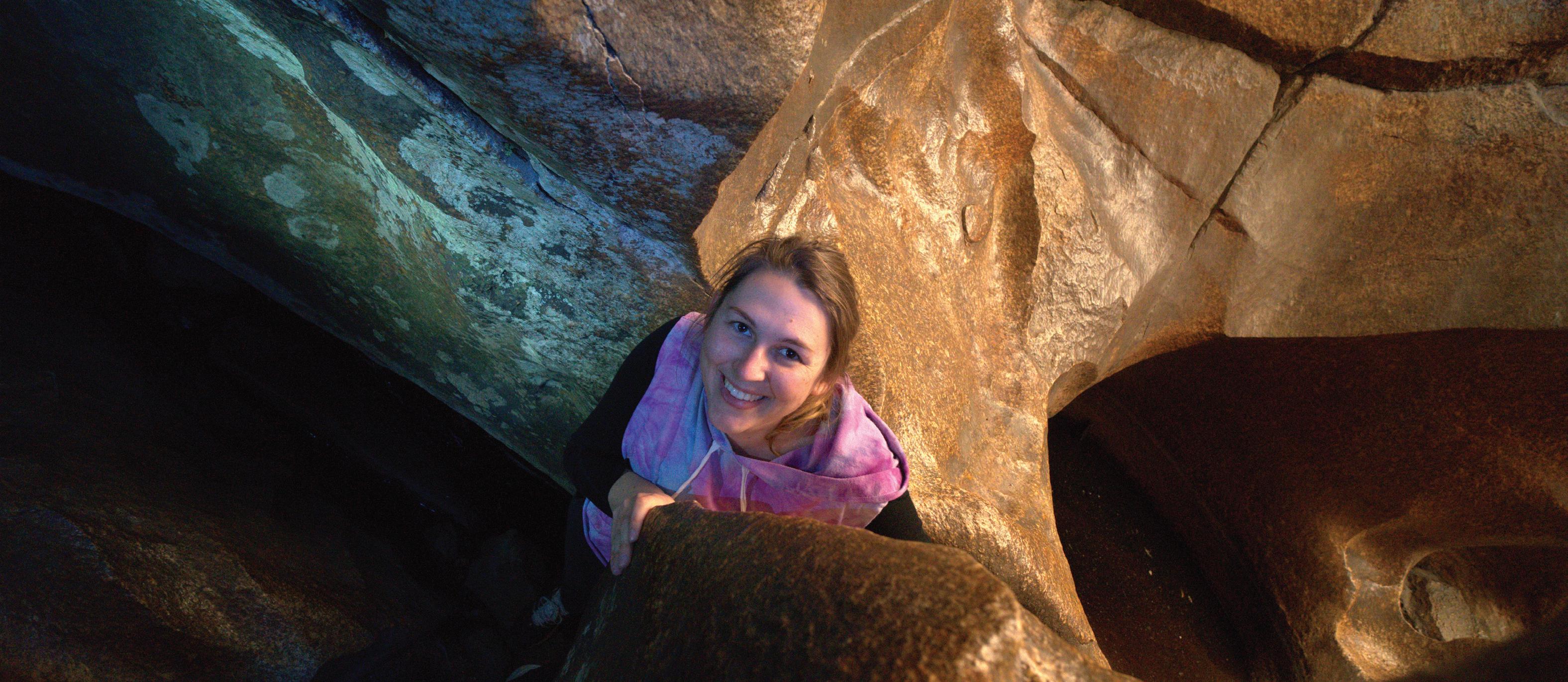
UP, VOTE, AND SHOW UP FOR NATURE ALWAYS—EVEN IF YOU’VE NEVER HEARD OF CANADIAN
THANK GOODNESS sometimes the apple really doesn’t fall far from the tree. Like Jillian Roberts has always been into “eco stuff” mainly because her family has always been, too. Dad, Eddie, was an early member of the Association of Whistler Area Residents for the Environment (AWARE), and mom, Barb, worked in guest relations on the mountains.
So Jillian’s one of those rare gems: A
 BY GLENDA BARTOSH
BY GLENDA BARTOSH
kid who grew up in Whistler going to bear camps with Michael Allen, then learned her chops elsewhere and came back to add her unique talent to the community. In 2001, when she was 10, the Roberts moved to Australia, home to droughts, floods and the oldest rocks on the planet, where Jillian worked hard as an ecologist to protect koala populations. Until it got too depressing. (“It felt like there was bad news, and then there was worse news.”)
As a little kid, she was horrified whenever she witnessed bad things happening to the environment. Her brother, Byron, was the same.
“I was so shy I wouldn’t usually talk to anyone,” says Jillian, who now confidently tutors students and takes them through the Whistler Museum, where she works as an oral
historian and researcher. “But if bigger kids were squishing frogs, I’d take their sticks and give them a talking to!”
That’s what I call picking your fights. And right now we all should be fighting the fight of our lives to protect our natural world. But Canadian Environment Week—which Canada established way back in 1971 (!) to build awareness about the environment, and what we need to do better—is on the horizon June 2 to 8, and who even knows it’s happening?
I’ve never studied koalas. In fact, I’ve never been to Oz even though I’ve longed to see wild kangaroos since fifth grade when we studied Australia.
Still, Jillian and I have some things in common. She’s 32—close to the age I was when I bought the Whistler Question, a great age to tackle dynamic challenges.
We both marched in the 2019 Climate Strikes. She in Brisbane, marching alongside 30,000 people who’d taken time off from school and work to support the environment— along with the millions more striking around the world, including impassioned Sea to Sky students. In Vancouver, where I marched, school kids chanted, “You die of old age, we die of climate change!” as 100,000 of us flooded downtown.
Then came COVID-19 on the heels of those strikes. Then lockdown. And now it seems everybody, or at least a certain demographic, is back flying to Cancun for the weekend. Either that or shopping. (The Walmartization of weddings is a thing?) Mention “Greta Thunberg” today, and people go, oh yeah… then check their phones.
Regardless, Jillian and I—and tons of
others out there fighting for the future—think all the adults in the room need to get a grip and get serious so kids today don’t have to clean up our mess tomorrow. That starts with the mess we’ve made of our climate in only 100 years. All of which makes me shake my head in disbelief as I see few signs of Canadian Environment Week, not even at the Resort Municipality of Whistler!
Seems we’re all excellent at marking Earth Day, which started in the U.S. in 1970 to raise awareness about environmental issues. So is this another case of the elephant down south over-shadowing an event Canada started at nearly the same time to do the same thing? Or maybe Whistler is already so eco-aware we’re jaded. Like right now there’s the Stewards of the Land exhibition at the Sk_wx_wú7mesh Li’wat7úl Cultural Centre, while AWARE and the Whistler Naturalists have lots going on, from repair cafés to bird walks.
Either way, there’s something about having our own national Made-in-Canada, week-long convo about our environment and how to better protect it, especially when that week includes World Environment Day (this year’s theme: Generation Restoration) and Canada’s Clean Air Day, both on June 5. Plus there’s World Oceans Day, June 8.
Maybe it’s all too much, too confusing. But personally, I think they should all be days off, like the Climate Strikes—time to do something dynamic. And we could even add more.
On top of “special” days, though, we all need to live so seamlessly low-impact every day, that it’s natural. As Jillian says, every week should be Environment Week.
These days, Jillian is in her element working with kids. “I love seeing them get excited about the world around them,” she says. “I used to run a program where we took digital microscopes out into the backyard, and watching the thrill of a kid who has just seen moss or an ant walking under the microscope is priceless.”
As an advocate for lifelong learning and staying curious, she loves fostering that in all age groups since it also develops an understanding and love for the world around us.
And when you feel that way, you naturally make wise lifestyle choices, as do Jillian, and her husband, Darcy Harriss—who can be found every day on the mountain or on his bike. They consider the environment in almost all of their daily decisions: Eating less red meat and dairy—good for the planet and your health. Consuming less, wasting less. (“The three R’s come in order of importance, No. 1 being reduce,” notes Jillian.) Turning down the thermostat, hanging their clothes to dry, choosing active transport, and carpooling to avoid excess driving. It all adds up.
“We should all do what we can, but don’t beat yourself up too bad when you’re not perfect,” Jillian says. “Just keep trying, and keep up the pressure on government and industry to do better.”
“Most of all, treat every week like Environment Week,” she adds. “Speak up, vote and show up for our natural world. Stay engaged.”
Use #EnviroWeek and #GreeningOurFuture to connect with Canadian Environment Week.
Glenda Bartosh is an award-winning journalist who will fight for the natural world until she finally drifts away and leaves it. n


F FLEXIBLE REGISTRATION Flex-reg’classeshavea separate feeand allowyou to registerfor classesonthe days that fit your schedule
R REGISTERED FITNESS Registeredfitnessclasses have aseparatefee anda defined start andend date Pre-registrationisrequired forthe entire setofclasses.
I INCLUDED FITNESS Theseclassesare included with your priceofadmission fornoextra charge



Saturday, May25and Sunday, May26
To suppor tthisevent theMPSCPool is closed from noon to 7:30 p.m. bothdays. Thank youfor your cooperation, and bestoflucktoall the 152 swimmers attending themeet! Scan theQRcode fordetails
604-935-PLAY(7529) RMOWRecreation






OF THE LAND’ IS ON DISPLAY UNTIL JUNE 30
BY DAVID SONGIN TRADITIONAL Squamish ( Sk_wx_ wú7mesh Úxwumixw) and Lil’wat (Líl’wat7úl) culture, stewardship is a communal affair. Taking care of territory is not the job of a select few, but rather an aim shared throughout society.
“Stewards of the Land,” a new display at the Squamish Lil’wat Cultural Centre (SLCC), aims to showcase this worldview. According to SLCC curator Alison Pascal, the exhibit was brought in because it follows up on several previous ones that also explored the history of First Nations land and related struggles for justice and equality.
“If [stewardship] is just one person’s responsibility, we could always put the blame on one person and it’s easier to transfer that blame,” says SLCC assistant curator Dominique Nahee. “Whereas if everybody knows these teachings, we’re all sharing that burden and weight.”
Like most other Indigenous cultures, the Squamish and Lil’wat have traditionally made full use of everything at hand. For
instance: while the meat of a hunted animal is consumed, its skins or furs are turned into clothing and bones or antlers are crafted into tools. Even fish bones are returned to the rivers from whence they came after soups and broths are cooked.
Rampant consumerism has eroded those ways with its focus on short-term
generations have enough clean air, clean water and good food to eat.
“You can already see the decline in the health of the Earth through the melting of all of the glaciers. Ever since I was young, we’ve been learning about [environmentalism] in school and certain groups have been talking about it—but overall, society isn’t listening
“As a collective of human beings living in the same place, it’s to our benefit to start making changes.”
- ALISON PASCAL
convenience and instant gratification, but many First Nations people wish to bring the prudent practice of sustainability back into the public eye.
“People go out for coffee and they get single-use cups, single-use plastic items and all of these things. That drive to make single-use items promotes the economy on one hand, but it’s not really sustainable,” Pascal remarks. “As Indigenous people, we look forward to ensuring that our future
because plastic bags are finally now widely available. Society is taking a really long time to let go of these conveniences.”
When it comes to safeguarding the biosphere, land and water go hand-in-hand. That’s why “Stewards of the Land” includes a portion on the Howe Sound Marine Stewardship Initiative:
a comprehensive assemblage of reports about the evolving hydrology of Howe Sound and the impact of human activities upon its waterways.
Although rapid industrialization in the 20th century had a significant deleterious effect upon Howe Sound ecosystems, the Marine Stewardship Initiative and other local projects are doing their part to restore balance. A key milestone occurred in 2021, when the area was designated as a UNESCO Biosphere Reserve.
Furthermore, the exhibit features an interactive component to engage and educate visitors about sustainable harvesting. In this context, “harvesting” refers not just to agricultural methods but more generally to the way we take resources from our environment. The key, Nahee says, is to leave enough for those who show up after you—even if all you’re doing is picking up rocks during a walk through the forest.
“We’re on the edge of looking at a new world and new patterns of weather,” adds Pascal. “As a collective of human beings living in the same place, it’s to our benefit to start making changes. It’s really important for us as Indigenous people here to educate people that we share this land with, but also to educate our own children that might not learn stewardship at home or school.”
“Stewards of the Land” will be available until June 30. Find more information at slcc. ca/exhibits/steward-of-the-land. n
ON MAY 14, the Whistler Film Festival Society (WFFS) convened a Special General Meeting (SGM) in Vancouver. A number of WFFS bylaws were revised—much to the chagrin of Shauna Hardy, who founded the Society in 2002 alongside Kasi Lubin.
Among the most significant developments was the rescindment of a long-standing provision which allowed the Founding Member of the Board (i.e. Hardy) to appoint someone, including themselves, to the Board every year.
“We were advised that this capacity for someone to be able to appoint themselves in perpetuity, is not in the interest of good governance,” said WFFS chair Sue Brouse in an email to Pique
“Updating the specific bylaw in question ensures the Society’s board seats are open and available to anyone who wishes to stand for election and promotes the attraction of board members who can bring a diversity of skills, perspectives and experience to benefit the Whistler Film Festival, its funders, members and fans. The changes are in the best interest of the Whistler Film Festival and are not intended to alter any agreement between the Founder and the Society.”
Hardy saw things differently prior to the vote. On May 13, she disseminated a letter to WFFS members urging them to submit proxy votes opposing the amendment (votes that were denied as they were received past the necessary deadline). She also filed an unsuccessful petition to the BC Supreme Court to block the meeting four days before it took place.
In her letter, Hardy claimed there are “serious issues” with the proposed changes and a “lack of transparency” from the board in terms of why they were recommending such changes.
“The amendments will also allow the Board to remove me as a Director of the Society as they consider me ‘a problem member’ for questioning their actions, which could be effective immediately after the meeting,” she wrote.
“There is no evidence—although I have repeatedly requested it—in regard to me being a ‘problem director,’ that I am in ‘material conflict’ or that my objectives are ‘consistently contrary to those of the Society,’ nor has any procedural fairness or due process been granted in regard to specific accusations made by the Board Chair.”
Moreover, Hardy pointed out WFFS bylaws were last updated in August 2022 in compliance with the BC Societies Act, and questioned why the Board modified them again within 20 months.
“I was surprised by the board’s direction on the Special General Meeting and bylaw updates and feel that the communication issued to the membership was misleading,” Hardy said in
an email interview. “I believe the resolutions deserved to be addressed and fulsomely debated with members at the Annual General Meeting in August with a wholesome picture of the current state of affairs.”
One other notable edit pertains to membership.
“The changes in membership clarifies that ‘members’ under the Motion Picture Act —ticket purchasers, a.k.a. viewing members— are not voting members,” explained Brouse. “Currently the Film Classification Board requires everyone who wants to see a film at the festival to buy a membership, as the majority of films we screen are unclassified.
“Our bylaws did not differentiate between members who simply bought a ticket because they were required to in order to see a film, and those who have a more meaningful engagement with the Society and could therefore be more invested in it as a voting member.”
Now, the WFFS has three categories of membership: viewers who just want to watch movies, voters who aim to get involved as filmmakers or donors, and founders like Hardy and Lubin. Viewing members can become voters by applying, and sponsors at a certain level will appoint a representative to vote on their behalf.
The current model resembles that found in other organizations like the Vancouver International Film Festival (VIFF).
“According to the Society’s bylaws, it is our duty as board directors to act honestly and in
“The changes are in the best interest of the Whistler Film Festival and are not intended to alter any agreement...”
- SUE BROUSE
good faith with a view to the best interests of the Society. As a founder of the Whistler Film Festival, longest-serving board member and employee for 20 years, and registered owner of the Whistler Film Festival trademarks, I remain committed to the best interests of the Society,” Hardy wrote to Pique, adding she is optimistic the board will honour the trademark agreement.
“I believe the arts uplift humanity. My sincere hope is that the Whistler Film Festival remains successful and relevant, both economically and culturally, for the benefit of the Whistler community and Canadian screen-based entertainment industry, which it has served for 24 years.” n
Here’s a quick look at some events happening in Whistler this week and beyond. FIND MORE LOCAL EVENT LISTINGS (and submit your own for free!) at piquenewsmagazine.com/local-events
•50yearmanufacturing
•10yearworkmanship


Ecologists Ryan Durand and Tyson Ehlers will present a photo-rich overview of slime moulds and thier work to uncover their diversity in BC While slime moulds may resemble fungi, they are only distantly related and relatively little is known about these enigmatic creatures in BC They are unicellular organisms with surprisingly complex structures and behaviour, such as the ability to learn and solve mazes.
As a self-taught mycologist, slime moulds have been on Pam Janszen's radar for over 25 years. Somewhere after 500+ fungal species, she found herself getting really interested in Myxomycetes (aka slime moulds). Pam will share how she got hooked on slime Myxos and explain their fascinating life cycle.

Everyone can sell, everyone can buy! Find everything and anything at the Community Garage Sale in Creekside, held twice-yearly. From household goods, to kids and baby stuff, clothing and sporting goods. Vendors can set up on a first-come, first-served basis for $25, no registration necessary. Find more info at awarewhistler.org.
> May 26, 10 a.m. to 2 p.m.
> Creekside Underground Parkade
> Free
Join local artist, muralist and professor of fine arts Lacey Jane for a fun evening of wine and painting wildlife in a casual setting. All skill levels are welcome, whether you are a proficient painter or have never held a brush before, this class is open to all.
> May 26, 7 to 9 p.m.
> The Point Artist-Run Centre
> $40 (includes a glass of wine)


A feast for your senses, the Whistler Farmers’ Market features local produce, tasty food, local artisans, live entertainment and family activities. Markets happen every Sunday until Thanksgiving on Oct. 13, with the addition of Saturday markets on June 29, Aug. 3, Aug. 31 and Oct. 12.
> May 26, 11 a.m. to 4 p.m.
> Upper Village Stroll
> Free
Are you looking for a place to enjoy tea and company while drawing, collaging, beading or fibre crafting? The Art Hive welcomes anyone looking for a space to work on art projects, experiment with different media, share ideas or just to hang-out and be creative. Whether working on a solo or collaborative project, gather in the community room and make something beautiful together.
> May 29, 6 to 8 p.m.
> Whistler Public Library
> Free

Volume on forALL Canadian teams! Wear your team’s colors when youcomein
Giveaway











Are you passionate about preserving Whistler’s unique history?
The Whistler Museum and Archives Society (WMAS) is seeking dedicated individuals to join our board of directors.
Please email executive Director BraDley Nichols at curator@whistlermuseum.org if you are iNteresteD iN the wmas BoarD aND for aN iNtroDuctioN to the NomiNatioN committee.


IN THE EARLY YEARS of lift operations on Whistler Mountain, the end of the ski season was sometimes determined not by the conditions or lack of snow, but by a lack of skiers. For some skiers, the end of the Easter holidays marked the time to put away their skis and start pulling out tennis rackets, even if the chairlifts were still running. In order to keep people coming to the ski area through May, Whistler Mountain hosted a Ski or Spring (the name depended on the year) Carnival over the May long weekend.
According to Hugh Smythe, who began working for the lift company in its first season, this effort to keep skiers in the area was driven in large part by Jack Bright, who arrived at Whistler Mountain as the new area manager in early 1967. While the mountain manager Dave Mathews was responsible for everything that moved on the hill, Bright was responsible for everything else, including marketing.
The first Carnival took place in 1967, though there is little information about it in the archives apart from a mention in the April 22, 1967 edition of Ski Trails, advertising “a razzle-dazzle weekend lined up that will include queen candidates, races and a variety of hijinks.” By the spring of 1968, however, the publication of Garibaldi’s Whistler News (GWN) provided much more detail about the event.
The Ski Carnival of 1968 began on Friday, May 17 with a “ski cruise” from Vancouver to Squamish up the Howe Sound with entertainment and refreshments. From Squamish, skiers were transported by bus to Whistler Mountain to prepare for the events of Saturday, which included an obstacle race, a gelandesprung contest (while gelandesprung is a type of jump in skiing, it was described in GWN as “people on skis will be jumping off things”), a fashion show, and a Carnival Ball in the Roundhouse. The
Ball had a dress code of “informal après ski wear,” with attendees having to make their way over from the top of the Red Chair.
On Sunday, the World Championship Inner Tube Race was followed by a “fairly legitimate, though easy” slalom race, and a barbecue at one of the lakes in the valley. After a morning of skiing on Monday, skiers were encouraged to attend the rodeo in Mount Currie hosted by members of the Lil’wat Nation. The schedule for the Spring Carnival of 1969 was very similar, though the cruise appears to have been replaced with sailboat races.
Hosting events like the Carnival was just one of the many ways skiing on Whistler was advertised during Bright’s tenure. He and Lynn Mathews published GWN three to four times a year, and distributed it as widely as possible. Bright also attended and sent employees to meetings with ski clubs and tour operators, as well as ski shows across North America. He even hired Jim Rice to make a ski movie on Whistler Mountain so they had something to show at these meetings and shows.
On Sundays, ski instructors would put on their uniforms to show ski films in Roy and Jane Ferris’ living room at the Highland Lodge so guests could see what the coming week might look like, and in 1968, convinced that the ski school needed a big name to attract more skiers, Bright and Smythe went to Tod Mountain (today Sun Peaks) to persuade Jim McConkey to be the new skischool director at Whistler.
In the mid-1970s, Bright and his wife Ann developed the Whistler Inn and JB’s Restaurant (today Roland’s), which they continued to operate after Bright left the lift company.
Although there is no official Ski or Spring Carnival hosted on Whistler Mountain today, decades of marketing efforts, beginning with those of Jack Bright and other early lift-company employees, ensure few skiers or riders are unaware the ski season goes into May. n
WEEK OF MAY 24 BY ROB
ARIES (March 21-April 19): In the coming weeks, you will experience uncomfortable weirdness if you do the following: 1. Meander without focus or purpose; 2. Give yourself permission to postpone, procrastinate, and engage in avoidance behaviour; 3. Ignore the interesting though challenging truths that are right in front of you; 4. Hang out with people with mediocre ambitions. But you will experience healthy, uplifting oddness if you do the following: 1. Trust your instincts and intuitions; 2. Authorize your spontaneity to invigorate and guide you; 3. Take the straightforward path that gets you to the destination most efficiently; 4. Be crisp and nimble.
TAURUS (April 20-May 20): Mysterious energies will soon begin healing at least some of the wounds in your financial genius. As a result, I predict new powers of attraction will awaken in you, making it likely you will add to your wealth in the coming months. To synergize these happy developments, I recommend you give yourself permission to have joyous fun as you lust for more cash. More good news: I will supplement your good fortune by casting a benevolent spell to boost the flow of riches into your bank account.
GEMINI (May 21-June 20): When I first got my job writing a horoscope column, I wasn’t looking for it. It found me. My bike had been stolen, and I was looking for a new one in the classified ads of the Good Times, the local Santa Cruz newspaper. There I serendipitously spied a “Help Wanted” ad. The publisher of the Good Times was hiring a new astrology writer to replace Robert Cole, who had just quit. I quickly applied for the gig and got it. Ever since, Robert Cole has been a symbol for me of an accidental and unexpected opportunity appearing out of nowhere. I mention this, Gemini, because when I meditate on you lately, I see the face of Robert Cole.
CANCER (June 21-July 22): In myths and legends, the consummate spiritual goal has various names: the Holy Grail, philosopher’s stone, pearl of great price, nirvana, alchemical gold, key of life, and many others. I appreciate this profusion of sacred symbols. It encourages us to not be too literal about identifying the highest reward. The old fables are equally equivocal about where the prize can be found. Is it in an empty desert or dark forest? In the deepest abyss, on a mountaintop, or in the backyard? I bring these thoughts to your attention, Cancerian, because the coming months will be an excellent time to conduct a quest for the marvellous treasure. What do you need most right now? What’s the best way to begin your search?
LEO (July 23-Aug. 22): I have good news for any Leos who are devoted to pragmatism and rational analysis. Just this once, my horoscope will offer no lyrical teasers or mystical riddles. Your pressing need for no-nonsense grit has moved me to offer straightforward, unembellished counsel. Here it is, dear: Cultivate connections that will serve your passionate ambitions. Make vigorous use of your network and community to gather information that will serve your passionate ambitions. Meditate on what course corrections might be necessary to serve your passionate ambitions.
VIRGO (Aug. 23-Sept. 22): For many of you Virgos, your health seems chronically unsettled. You may be constantly hyper-vigilant about the next glitch that could possibly affect your well-being. There’s a problem with that approach: It may intensify your fear of frailty, which in turn saps your vigour. But I’m happy to report that in the coming months, you will have an enhanced power to break out of this pattern. To get started, try this: Every morning for four minutes, picture yourself overflowing with vitality. Visualize every part of your body working with joyful heartiness. Send streams of love and gratitude to all your organs. Do this for the next 21 days.
LIBRA (Sept. 23-Oct. 22): Many people regard the word “faith” as referring to delusional hope or wishful thinking. But I ask you to rethink its meaning—and consider the
BREZSNYpossibility that it could be an empowering force in the coming months. How? Imagine a faith that’s earthy and robust. You actually feel it vibrating in your heart and gut. It literally alters your brain chemistry, fortifying your natural talents and attracting needed resources. It liberates you to feel pragmatically excited as you pursue your goal of fulfilling your soul’s code.
SCORPIO (Oct. 23-Nov. 21): When I was born, my parents gave me the name “Robert.” It’s derived from an Old North French word meaning “shining” and “bright with glory.” In Middle English, though, “robert” was a designation for “a wastrel, a marauder, a good-fornothing.” I use this dichotomy as a reminder that my own nature is a mix of brightness and darkness. A lot of me is shining and inspirational, but there’s also a part that’s ignorant and confused. And what’s true about me is true about everyone else, including you: We are blends of the best and the not-so-best. Now is a good time to draw strength and wisdom from meditating on this reality. Your shadowy aspects have important and interesting truths to reveal to your brilliant aspects—and vice versa.
SAGITTARIUS (Nov. 22-Dec. 21): Here are some meditations on emotions. They are as key to our intelligence as our thoughts! But it’s crucial that we distinguish between emotions generated by delusions and emotions that are responses to true perceptions. Let’s say I get angry because I imagine a friend stole money from my room while visiting, but then later I put on my vest and find the supposedly stolen cash in the vest pocket. That is a delusional emotion. But if I am sad because my friend’s beloved dog is sick, that is emotion based on an accurate perception. I bring this to your attention, Sagittarius, because I believe it is essential that in the coming weeks you discern between the two types.
CAPRICORN (Dec. 22-Jan. 19): As an adjunct to the Ten Commandments, I have formulated the Ten Suggestions. Here’s Suggestion No. 1: Wash your own brain at least three times a year. I’m speaking metaphorically, of course. What I mean is that like me and everyone else, you are always accumulating junky thoughts and useless feelings. Some are generated by our old, conditioned responses, and some pour into us from the media and entertainment industries. And it’s best to be proactive about the toxic build-up—not allow it to become monumental. In my astrological opinion, now is an excellent time for a regular mind cleanse.
AQUARIUS (Jan. 20-Feb. 18): So many writers have said terrible things about our existence on planet Earth. “Life is a disease,” wrote George Bernard Shaw. “Life is a bad dream,” declared Eugene O’Neill. Life is “a vast cold junkpile,” according to Stephen King. There are thousands more of these unnuanced disparagements. Why? Here are the facts, as I see them: As tough as it can be to navigate through problems and pain, being alive in our miraculous bodies with our dazzling awareness is a sublime gift. We are all blessed with a mysterious and fascinating destiny. In accordance with the astrological omens, Aquarius, I invite you to celebrate being alive with extra gratitude and ebullience. Begin the jubilee by feeling amazement and awe for your mysterious and fascinating destiny. Second step: Identify five sublime gifts in your life.
PISCES (Feb. 19-March 20): In the coming weeks, I ask you to refrain from indulging in extreme nostalgia. On the other hand, I encourage you to explore the past and sift through memories with the intention of clarifying what really happened back then. Pluck new lessons from the old days that will help you forge smart decisions in the near future. Use your history as a resource while you redefine the meanings of pivotal events. For extra credit, create a new title for the book you may someday write about your life story.
Homework: Read and hear free excerpts from my book: https://tinyurl.com/BraveBliss.
In addition to this column, Rob Brezsny creates
In-depth weekly forecasts designed to inspire and uplift you. To buy access, phone 1-888-499-4425. Once you’ve chosen the Block of Time you like, call 1-888-682-8777 to hear Rob’s forecasts. www.freewillastrology.com


DINNER NIGHTLY from 5:30 pm
Reservations recommended 604.932.2223 / teppanvillage.ca
TAKE NOTICE THAT the District of Squamish, in accordance with District of Squamish Procedure Bylaw No 2099, 2009, will reconsider their decision regarding the WLNG Temporar y Use Permit No. 76 at the Regular Council Meeting scheduled for June 4, 2024, at 6 p.m. in the Council Chambers at District of Squamish Municipal Hall, 37955 Second Avenue, Squamish, BC.
The purpose of the Temporar y Use Permit is to allow for a temporar y floating worker accommodation (Floatel) use on the proper ty outlined in black on the Location Map, for a period of up to three years. The Floatel will consist of 652 private rooms with ensuite washrooms, central cook ing, dining, and recreation facilities.

A copy of the proposed Temporar y Use Permit and related information that has been considered by Council may be inspec ted online or at Municipa l Hall
• squamish.ca (Listed under “Upcoming Meetings” on the home page.)
• 37955 Second Avenue, Squamish, British Columbia, from May 23 to June 4, 2024, between 8:30 a.m. and 4:30 p.m., Monday through Friday, excluding statutor y holidays.
Questions related to the Temporar y Use Permit can be directed to the Planning Department: 604.815.5002.
Î


Fairmont Chateau
Whistler Resort is growing its Housing portfolio and sourcing additional Chalet and Condo Rental contracts for our Hotel Team Members. Our leaders are mature, career driven drivers that know the word respect. Contract terms for property Owners are stress free with no commissions and includes representation from our 4 person fulltime Housing Department working with you 24/7; maintaining all aspects of the tenancy including quarterly inspections. A great next move for Whistler property Owners that have tired with the Airbnb game or Property Fees. Let’s see if we can make a match and develop a long-term relationship here. General inquiries please email mark.munn@fairmont.com






TEPPAN VILLAGE IS HIRING A GENERAL MANAGER
Teppan Village is a locally owned Teppanyaki Steakhouse
RESPONSIBILITIES INCLUDE:
• Overseeing daily operations
• Addressing areas of improvement
• Responding to customer service needs
• Insuring team member satisfaction
• Monitoring staff performance and scheduling.
THE PERFECT CANDIDATE:
• Minimum 4-5 years management experience in a high volume food and beverage environment
• Manage reservations systems
• Strong problem-solving abilities
• Excellent leadership, organization, and time management skills.
• Ability to develop and motivate staff to achieve challenging goals.
• Full-time, year-round career opportunity.
• Competitive wage
• Annual mountain pass.
• Free meals and restaurant discounts.
• Educational allowance & growth opportunities.
• Extended health, dental and vision benefits
• Paid vacation time
Address: 301-4293 Mountain Square, Whistler, BC, V0N 1B4
Apply by email at teppanvillage@shaw.ca



Looking to contribute to your local community?
Consider a career in local government. Join the SLRD’s team of dedicated staff who work together to make a difference in the region
Headquartered in Pemberton, the Squamish-Lillooet Regional District (SLRD) delivers a wide range of regional, sub-regional and local services to its residents. The SLRD is a BC Regional District consisting of four member municipalities (Squamish, Whistler, Pemberton, Lillooet) and four electoral areas. Services include land use planning, solid waste management, building inspection, fire protection, emergency preparedness, 911 services, recreation, water and sewer utilities, regional transit, trails and open spaces as well as financial support for various community services. The region contains some of the most spectacular forests, waterways, and mountains in the province and affords an endless range of opportunities for outdoor adventure, making it an exceptional place to live, work and play.
The SLRD is seeking a strategic and collaborative Information Technology (IT) professional to fill the position of IT Manager. The IT Manager is responsible for leading and guiding the effective operation of the SLRD’s IT systems and processes including IT business planning, hardware and software projects, data security management, resource management, and supervision of IT staff and contractors. The IT Manager plays both a strategic and hands-on role, managing IT projects and overseeing the identification, selection, and deployment of the appropriate IT solutions that support the SLRD’s strategic priorities.
The ideal candidate has a minimum of 5 years of related IT experience, at least 2 years of supervisory experience, and a post-secondary degree or diploma in Computer Science, Business IT Management or a related discipline. For further information, please refer to the full job description at www.slrd.bc.ca/ employment.
The salary range for this position is $115,520 - $130,019 annually. A comprehensive benefits package, participation in the Municipal Pension Plan, compressed work week (9-day fortnight), learning and career development and the eligibility to work from home in accordance with the SLRD’s Remote Work Arrangements Policy are available with this position. Interested candidates are invited to submit their cover letter and resume (preferably in pdf format) by email tocareers@slrd.bc.ca. This posting will remain open until filled, with application review commencing on June 3, 2024.
We sincerely thank all applicants for their interest, however, only candidates under consideration will be contacted.









RED DOOR BISTRO IS RECRUITING A HANDS-ON SOUS CHEF TO JOIN OUR SMALL PASSIONATE TEAM.
Sous Chef reports to R.D. Stewart, Executive Chef of Red Door Bistro & Rolands Creekside Pub Ideal candidates must be
Gratuities, and discounts in Roland’s Pub & Red Door Bistro
• Extended Medical & Dental benefits
• Ski pass • Gas and Cell phone allowance

Full Time Meat Manager
($68,640 – $79,040 (+ benefits) depending on experience) 10% Annual Bonus Based on Performance
Full Time Assistant Meat Manager
($64,480 – $72,800 (+ benefits) depending on experience)
Meat Cutter
($20.50/hr – $32.00/hr (+ 20% discount card & benefits) for full time staff)
Our Team enjoys:
ü Flexible schedules
ü Training and experience
ü Full Benefits & Employee Discount Card
ü Prime location in Pemberton
ü Short commute = less time, more $$$


• Duties include prepping/portioning/cooking steaks, seafood and pan cooking.
• Imagine working in a well respected fine dinning bistro which is well run, fun, and does 60-70 covers a night.
• Wage is $25-$28/hour based on experience, plus tips. Medical & Dental benefits and staff discounts in Roland’s Pub.
Download or fill out our online application at https://www.pembertonsupermarket.com/ about/employment/ or stop by the store and we will give you an application to fill out. You can also email us at jobs@pembertonsupermarket.com or call us at 604-894-3663. RED DOOR BISTRO IS SEEKING A FULL TIME LINE/GRILL COOK.



seeking
self-motivated individuals who love to work with people. Good communication, memory recall, math and multitasking skills, are required.
we offer: Nice work environment, monthly bonuses, Extended Health Benefits, staff discounts, flexible schedule and the opportunity to work where you live.
opportunity to grow with the





Ullus Community Centre
•
• Cultural coordinator ($38,038 - $53,599 per
$80,371.20 - $91,673.40 per year)
• Receptionist ($17.40 to $20.90 per hour)
• Human Resources Manager( $93,475.20 to $101,556.00 per year)
• Housing Administrator ( $46,683.00 to $63,973.00 per year)
• Transition House Support Worker ($20.90 - $29.45 per hour)
Xet’òlacw Community School
• Elementary School Teacher: Grade 3 ($60,015.00 to $109,520.00 per year)
• Educational Counsellor/ Teacher ($60,015.00 to $109,520.00 per year)
• High School English Teacher ($60,015.00 to $109,520.00 per year)
• High School English and Humanities Teacher ($60,015.00 to $109,520.00 per year)
• Language Resource Worker or Language Teacher ($46,683 - $63,973 per year)
• Social Worker/ Counsellor ($80,371.20 - $91,673.40 per year)
Lil’wat Health & Healing
• Nurse Manager ($85,685.60 - $117,280.80 per year)

Wages
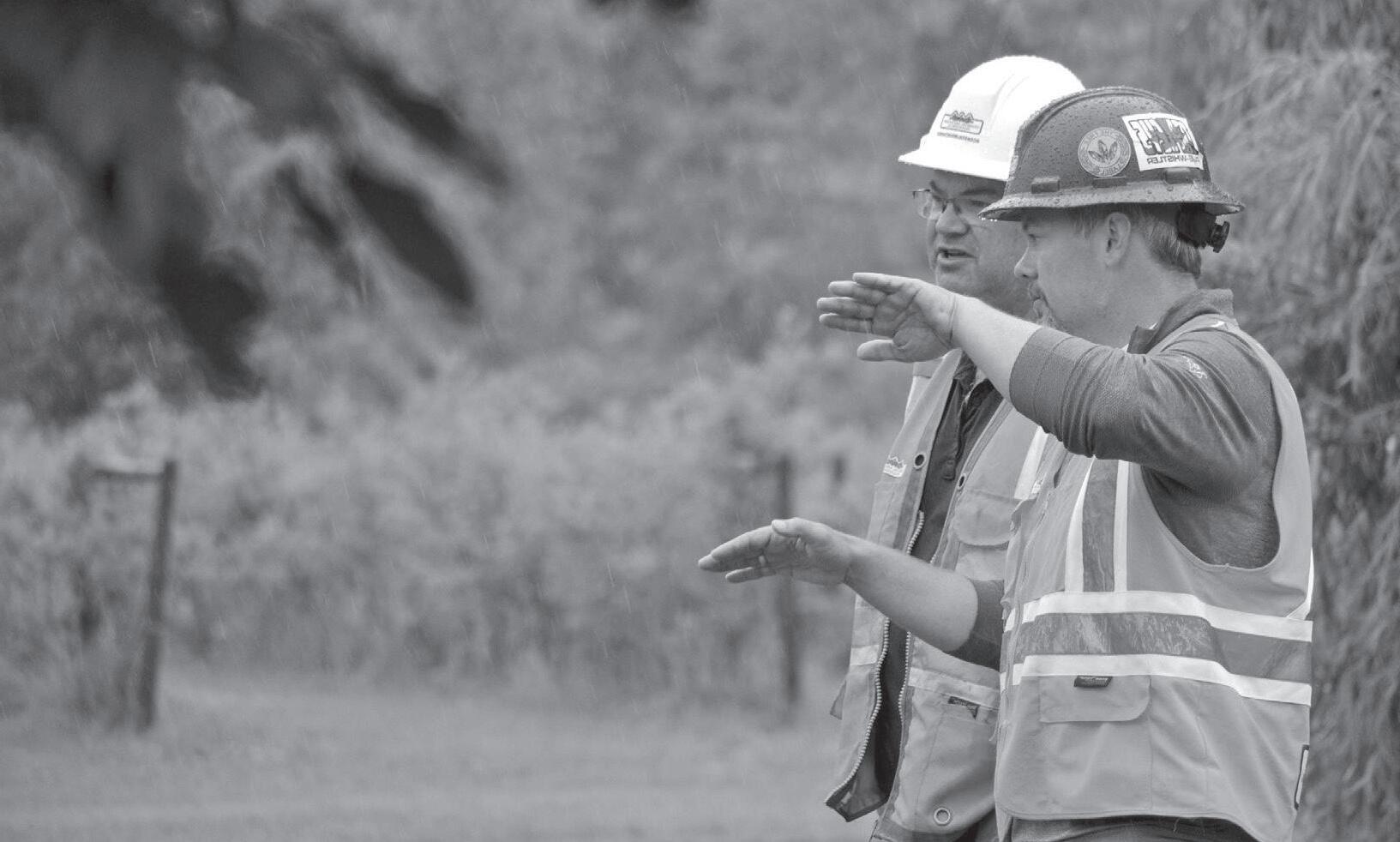










TRUCK DRIVER - Valid Class 1 or Class 3 with air brakes required. Manual transmission. 2 years experience preferred. $32-$40.45 per hour.




HEAVY EQUIPMENT OPERATOR, Squamish - Minimum 5 years or 5,000 hours operating experience on excavator. Full-time, Monday – Friday. $33-$42 per hour.
HEAVY DUTY EQUIPMENT MECHANIC, Whistler – Red Seal Certified, Commercial Truck & Transport, Transport Trailer required. CVSE Inspector’s ticket, Air Conditioning ticket, Class 1 or 3 with air brakes preferred. Toolbox available for rent. $39.70-$47.90 per hour. CONSTRUCTION LABOURER – Great opportunity to learn on-the-job. Stamina for physically demanding work and perseverance to brave inclement weather required. Previous experience preferred but not required. Training provided. $25-$32 per hour.


























I’M NOT given to much nostalgia. I don’t have a treasure trove of old pictures, letters, baseball cards kicking around. I moved a lot prior to living in Whistler and I never took much in the way of roots with me.
I don’t believe the good ol’ days were that good. I had fun, for sure, but with a decade knocking around the halls of “higher
 BY G.D. MAXWELL
BY G.D. MAXWELL
learning,” I put in my time living the life of an impoverished—and indebted—student, often wondering whether I’d be reduced to moving some contraband to meet next month’s rent.
My feet were itchy and I liked moving. Long road trips were a way of life. Long camping trips, too. Before settling into Smilin’ Dog Manor for summers, the months between Whistler or Blackcomb closing and opening were spent travelling and breaking down in Mello Yello, my 1983 VW Westfailya.
It’s long gone. But I recently found myself a bit wistful for the long summers of aimless travel.
Until I ran across this account of one such trip to escape the endless rains of spring. You remember rainy springs? Before smoky springs?
This particular Search for Spring— late 1990s—turned out to be the Journey of Many Shivers. A week of pre-departure sunshine lulled me into making unwise wardrobe choices, long on shorts, T-shirts and sunscreen; short on fleece, down, and large animal skins.
The travel theme for this vacation became 50 Ways to Warm Your Lover, 48 having to do with overcoming the body’s initial shock when it comes into contact with the ice-cold nylon interior of an otherwise toasty sleeping bag.
That left the two most effective methods: fire and hot springs. Hot springs never seem as handy as they should be. And you can’t stay in them all night, though I’ve tried.
So fire it was. Most people have a primordial attraction and fascination with fire. Especially in Canada, where long stretches of cold weather and an abundance of forests conspired to produce the best damn fire builders in the known universe. Yeah, Baby, We’re No. 1!
Before I moved to Canada, I thought I made pretty passable campfires, though I preferred not to. Sparks always seemed to find my rainfly, my clothes, my beard, my beer. Being a wind magnet, I was in the path of smoke regardless of where I sat. If I chose not to sit, in a pointless attempt to outfox the smoke, my motion created a sufficient vortex to ensure smoke would engulf me in a permanent spiral. After a couple of days, I both felt and smelled like a kipper.
Knowing the importance of warmth to survival, however, I dutifully learned to carefully collect dry tinder—needles, moss, fine twigs, last Sunday’s New York Times, if one was handy—sort sticks from small to large, and patiently bring the entire mess to

fiery life with only a single match... and half a quart of stove fuel. Lacking stove fuel, I found it more efficient to just swallow the burning match, wash it down with a large scotch and crawl into my ice-cold sleeping bag until morning.
On rare occasions where lots of dry wood and a desire for fire came together in time and space, I managed to put together some pretty great fires. Campfire myth is Natives (generic North American First Nations people) build small fires, stand close to them and get warm,
At a lake outside Kamloops, I camped on the shores of what would have been a perfect trout lake had all the trout not been preoccupied making new trout in a ritual orgy of sex and depravity. The Forest Service had kindly created a “primitive” campground at this particular lake. It consisted of a couple of pit toilets and circular, metal fire rings way too small to ever hold a campfire created by a Real Canadian Male. Judging by the many
I was humbled when I moved to Canada. Canadians know fire. I camped near a Canadian Guy on one trip who was, I swear, forging steel in his campfire.
while White Men (generic North American Males) build big fires they have to stand so far away from only one side feels warmth. In those pre-deposit days, I built fires hot enough to vaporize aluminum beer cans, light joints held three feet away, and reduce the hair on my forearms to a fine, white ash.
But I was humbled when I moved to Canada. Canadians know fire. I camped near a Canadian Guy on one trip who was, I swear, forging steel in his campfire. Sleep that night came to the rhythmic ringing of his hammer straightening, I believe, the rear axle of his
telltale rock rings and scorched, circular patches of earth, either no one paid much attention to the established fire pits or this lake is frequently visited by aliens practicing crop circles.
There were several “camps” at this lake of mind-boggling proportions. It looked as though whole extended families, possibly rural villages, had encamped, maybe for the entire summer. One of these, the Camp of Many Dwellings, contained the following structures: a large fifth-wheel house trailer; a motorhome; two pop-up trailer tents; one
pick-up camper of teetering proportions; two enormous walled tents; two sizable dome tents; and three well-hung tarps shading an area not much smaller than a football field.
Several picnic tables had been arranged as food-preparation surfaces. There were two elevated lanterns attached to 20-pound propane tanks, two four-burner stoves, a generator, a small chest freezer, an air compressor to inflate a half dozen belly boats, coolers too numerous to count, a large wooden structure that was either a hope chest or a coffin, a sun shower complete with shower stall, and enough lawn chairs to hold a good sized concert audience. The camp was ringed and protected by a veritable used-car lot full of pickups and SUVs.
All of the above didn’t seem particularly out of the ordinary. Camping is sufficiently flexible to embrace this collection as well as no-trace backpacking. What did strike me as unusual was the three cords of wood cut, split and stacked high between several spindly birch trees. There was more wood at this camp than I’d burned in the last several winters combined, and more, I thought, than anyone could possibly burn in the 14-day stay limit requested by the Forest Service.
Needless to say, well after the sun set in the west—this is a presumption on my part since I never saw the damn thing—the woods to the east glowed long into the night as flames danced and leapt into the lower branches of trees surrounding the Camp of Many Dwellings.
The experience was instrumental in my decision a few years later to buy a cottage. ■
Land Rover. His fire still burned early the next morning.









